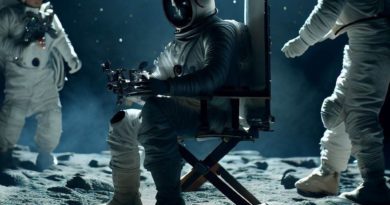Moon landing conspiracy theories

Moon landing conspiracy theories
Jump to navigation Jump to search
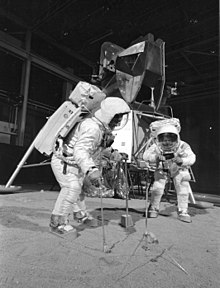
Astronauts Buzz Aldrin and Neil Armstrong in NASA’s training mockup of the Moon and the Apollo Lunar Module. Conspiracy theorists say that the films of the missions were made using sets similar to this training mockup.
Moon landing conspiracy theories claim that some or all elements of the Apollo program and the associated Moon landings were hoaxes staged by NASA, possibly with the aid of other organizations. The most notable claim is that the six crewed landings (1969–1972) were faked and that twelve Apollo astronauts did not actually walk on the Moon. Various groups and individuals have made claims since the mid-1970s that NASA and others knowingly misled the public into believing the landings happened, by manufacturing, tampering with, or destroying evidence including photos, telemetry tapes, radio and TV transmissions, and Moon rock samples.
Much third-party evidence for the landings exists, and detailed rebuttals to the hoax claims have been made.[1] Since the late 2000s, high-definition photos taken by the Lunar Reconnaissance Orbiter (LRO) of the Apollo landing sites have captured the lander modules and the tracks left by the astronauts.[2][3] In 2012, images were released showing five of the six Apollo missions’ American flags erected on the Moon still standing; the exception is that of Apollo 11, which has lain on the lunar surface since being accidentally blown over by the takeoff rocket’s exhaust.[4][5]
Conspiracists have managed to sustain public interest in their theories for more than 40 years, despite the rebuttals and third-party evidence. Opinion polls taken in various locations have shown that between 6% and 20% of Americans, 25% of Britons, and 28% of Russians surveyed believe that the crewed landings were faked. Even as late as 2001, the Fox television network documentary Conspiracy Theory: Did We Land on the Moon? claimed NASA faked the first landing in 1969 to win the Space Race.[6]
Contents
- 1 Origins
- 2 Claimed motives of the United States and NASA
- 2.1 Space Race
- 2.2 NASA funding and prestige
- 2.3 Vietnam War
- 3 Hoax claims and rebuttals
- 3.1 Number of conspirators involved
- 3.2 Photographic and film oddities
- 3.3 Environment
- 3.4 Mechanical issues
- 3.5 Transmissions
- 3.6 Missing data
- 3.6.1 Tapes
- 3.6.2 Blueprints
- 3.7 NASA technology compared to USSR
- 3.8 Technology used by NASA
- 3.9 Deaths of NASA personnel
- 3.10 NASA response
- 3.11 Alleged Stanley Kubrick involvement
- 3.12 Academic work
- 3.13 MythBusters special
- 4 Third-party evidence of Moon landings
- 4.1 Imaging the landing sites
- 4.2 Moon rocks
- 4.3 Missions tracked by independent parties
- 4.4 Retroreflectors
- 5 Public opinion
- 6 See also
- 7 Notes
- 8 Citations
- 9 References
- 10 Further reading
- 11 External links
- 11.1 Television specials
Origins
An early and influential book about the subject of a moon-landing conspiracy, We Never Went to the Moon: America’s Thirty Billion Dollar Swindle, was self-published in 1976 by Bill Kaysing, a former US Navy officer with a Bachelor of Arts in English.[7] Despite having no knowledge of rockets or technical writing,[8] Kaysing was hired as a senior technical writer in 1956 by Rocketdyne, the company that built the F-1 engines used on the Saturn V rocket.[9][10] He served as head of the technical publications unit at the company’s Propulsion Field Laboratory until 1963. The many allegations in Kaysing’s book effectively began discussion of the Moon landings being faked.[11][12] The book claims that the chance of a successful crewed landing on the Moon was calculated to be 0.0017%, and that despite close monitoring by the USSR, it would have been easier for NASA to fake the Moon landings than to really go there.[13][14]
In 1980, the Flat Earth Society accused NASA of faking the landings, arguing that they were staged by Hollywood with Walt Disney sponsorship, based on a script by Arthur C. Clarke and directed by Stanley Kubrick.[a][15] Folklorist Linda Dégh suggests that writer-director Peter Hyams’ film Capricorn One (1978), which shows a hoaxed journey to Mars in a spacecraft that looks identical to the Apollo craft, might have given a boost to the hoax theory’s popularity in the post-Vietnam War era. Dégh sees a parallel with other attitudes during the post-Watergate era, when the American public were inclined to distrust official accounts. Dégh writes: “The mass media catapult these half-truths into a kind of twilight zone where people can make their guesses sound as truths. Mass media have a terrible impact on people who lack guidance.”[16] In A Man on the Moon,[17] first published in 1994, Andrew Chaikin mentions that at the time of Apollo 8’s lunar-orbit mission in December 1968,[18] similar conspiracy ideas were already in circulation.[19]
Claimed motives of the United States and NASA
Those who believe the Moon landings were faked give several theories about the motives of NASA and the United States government. The three main theories are below.
Space Race
Motivation for the United States to engage the Soviet Union in a Space Race can be traced to the then on-going Cold War. Landing on the Moon was viewed as a national and technological accomplishment that would generate world-wide acclaim. But going to the Moon would be risky and expensive, as exemplified by President John F. Kennedy famously stating in a 1962 speech that the United States chose to go because it was hard.[20]
Hoax theory debunker Phil Plait says in his book Bad Astronomy,[b] that the Soviets – with their own competing Moon program, an extensive intelligence network and a formidable scientific community able to analyze NASA data – would have ‘cried foul’ if the United States tried to fake a Moon landing,[21] especially since their own program had failed. Proving a hoax would have been a huge propaganda win for the Soviets.
Conspiracist Bart Sibrel responded, incorrectly asserting that, “the Soviets did not have the capability to track deep space craft until late in 1972, immediately after which, the last three Apollo missions were abruptly canceled.”[22]
In fact, the Soviets had been sending uncrewed spacecraft to the Moon since 1959,[23] and “during 1962, deep space tracking facilities were introduced at IP-15 in Ussuriisk and IP-16 in Evpatoria (Crimean Peninsula), while Saturn communication stations were added to IP-3, 4 and 14,”[24] the latter having a 100 million km (62 million mi) range.[25] The Soviet Union tracked the Apollo missions at the Space Transmissions Corps, which was “fully equipped with the latest intelligence-gathering and surveillance equipment.”[26] Vasily Mishin, in an interview for the article “The Moon Programme That Faltered,” describes how the Soviet Moon program dwindled after the Apollo landings.[27]
Also, there was nothing “abrupt” about the Apollo cancellations, which were made for cost-cutting reasons. These were announced in January and September 1970,[28] two full years before the “late 1972” claimed by Sibrel.[29] (See Vietnam War below.)
NASA funding and prestige
Conspiracy theorists claim that NASA faked the landings to avoid humiliation and to ensure that it continued to get funding. NASA raised “about US$30 billion” to go to the Moon, and Kaysing claimed in his book that this could have been used to “pay off” many people.[30] Since most conspiracists believe that sending men to the Moon was impossible at the time,[31] they argue that landings had to be faked to fulfill Kennedy’s 1961 goal, “before this decade is out, of landing a man on the Moon and returning him safely to the Earth.”[32] In fact, NASA accounted for the cost of Apollo to the US Congress in 1973, totaling US$25.4 billion.[33]
Mary Bennett and David Percy have claimed in Dark Moon: Apollo and the Whistle-Blowers, that, with all the known and unknown hazards,[34] NASA would not risk broadcasting an astronaut getting sick or dying on live television.[35] The counter-argument generally given is that NASA in fact did incur a great deal of public humiliation and potential political opposition to the program by losing an entire crew in the Apollo 1 fire during a ground test, leading to its upper management team being questioned by Senate and House of Representatives space oversight committees.[36] There was in fact no video broadcast during either the landing or takeoff because of technological limitations.[37]
Vietnam War
The American Patriot Friends Network claimed in 2009 that the landings helped the United States government distract public attention from the unpopular Vietnam War, and so crewed landings suddenly ended about the same time that the United States ended its involvement in the war.[38] In fact, the ending of the landings was not “sudden” (see The Space Race above). The war was one of several federal budget items with which NASA had to compete; NASA’s budget peaked in 1966, and fell by 42.3% by 1972.[39] This was the reason the final flights were cut, along with plans for even more ambitious follow-on programs such as a permanent space station and crewed flight to Mars.[40]
Hoax claims and rebuttals
Many Moon-landing conspiracy theories have been put forward, claiming either that the landings did not happen and that NASA employees have lied, or that the landings did happen but not in the way that has been told. Conspiracists have focused on perceived gaps or inconsistencies in the historical record of the missions. The foremost idea is that the whole crewed landing program was a hoax from start to end. Some claim that the technology to send men to the Moon was lacking or that the Van Allen radiation belts, solar flares, solar wind, coronal mass ejections and cosmic rays made such a trip impossible.[11]
Vince Calder and Andrew Johnson, scientists from Argonne National Laboratory, have given detailed answers to conspiracists’ claims on the laboratory’s website.[41] They show that NASA’s portrayal of the Moon landing is fundamentally accurate, allowing for such common mistakes as mislabeled photos and imperfect personal recollections. Using the scientific process, any hypothesis that is contradicted by the observable facts may be rejected. The ‘real landing’ hypothesis is a single story since it comes from a single source, but there is no unity in the hoax hypothesis because hoax accounts vary between conspiracists.[42]
Number of conspirators involved
According to James Longuski, the conspiracy theories are impossible because of their size and complexity. The conspiracy would have to involve more than 400,000 people who worked on the Apollo project for nearly ten years, the 12 men who walked on the Moon, the six others who flew with them as command module pilots, and another six astronauts who orbited the Moon.[c] Hundreds of thousands of people–including astronauts, scientists, engineers, technicians, and skilled laborers–would have had to keep the secret. Longuski argues that it would have been much easier to really land on the Moon than to generate such a huge conspiracy to fake the landings.[43][44] To date, nobody from the United States government or NASA linked to the Apollo program has said the Moon landings were hoaxes. Penn Jillette made note of this in the “Conspiracy Theories” episode of his television show Penn & Teller: Bullshit! in 2005.[45] With the number of people involved, and noting the Watergate scandal, Jillette noted that someone would have outed the hoax by now.
One rebuttal by Sibrel to this claim is that NASA had compartmentalized all of the work on the Apollo program. This would have allowed for only a small number of people to actually know the truth about faking the Moon landings.[46]
Photographic and film oddities
Moon-landing conspiracists focus heavily on NASA photos. They point to oddities in photos and films taken on the Moon. Photography experts (including those unrelated to NASA) have replied that the oddities are consistent with what should be expected from a real Moon landing, and are not consistent with tweaked or studio imagery. Some main arguments and counter-arguments are listed below.
1. In some photos, the crosshairs appear to be behind objects. The cameras were fitted with a Réseau plate (a clear glass plate with a reticle etched on), making it impossible for any photographed object to appear “in front” of the grid. Conspiracists often use this evidence to suggest that objects were “pasted” over the photographs, and hence obscure the reticle.
- This effect only appears in copied and scanned photos, not any originals. It is caused by overexposure: the bright white areas of the emulsion “bleed” over the thin black crosshairs. The crosshairs are only about 0.004 inches thick (0.1 mm) and emulsion would only have to bleed about half that much to fully obscure it. Furthermore, there are many photos where the middle of the crosshair is “washed-out” but the rest is intact. In some photos of the American flag, parts of one crosshair appear on the red stripes, but parts of the same crosshair are faded or invisible on the white stripes. There would have been no reason to “paste” white stripes onto the flag.[47]
@media all and (max-width:720px){.mw-parser-output .mod-gallery{width:100%!important}}.mw-parser-output .mod-gallery{display:table}.mw-parser-output .mod-gallery-default{background:transparent;margin-top:4px}.mw-parser-output .mod-gallery-center{margin-left:auto;margin-right:auto}.mw-parser-output .mod-gallery-left{float:left}.mw-parser-output .mod-gallery-right{float:right}.mw-parser-output .mod-gallery-none{float:none}.mw-parser-output .mod-gallery-collapsible{width:100%}.mw-parser-output .mod-gallery .title,.mw-parser-output .mod-gallery .main,.mw-parser-output .mod-gallery .footer{display:table-row}.mw-parser-output .mod-gallery .title>div{display:table-cell;text-align:center;font-weight:bold}.mw-parser-output .mod-gallery .main>div{display:table-cell}.mw-parser-output .mod-gallery .gallery{line-height:1.35em}.mw-parser-output .mod-gallery .footer>div{display:table-cell;text-align:right;font-size:80%;line-height:1em}.mw-parser-output .mod-gallery .title>div *,.mw-parser-output .mod-gallery .footer>div *{overflow:visible}.mw-parser-output .mod-gallery .gallerybox img{background:none!important}.mw-parser-output .mod-gallery .bordered-images .thumb img{border:solid #eaecf0 1px}.mw-parser-output .mod-gallery .whitebg .thumb{background:#fff!important}
-

Enlargement of a poor-quality 1998 scan – both the crosshair and part of the red stripe have “bled out”
-

Enlargement of a higher-quality 2004 scan – crosshair and red stripe visible
-
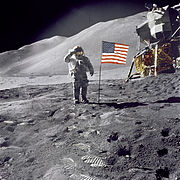
David Scott salutes the American flag during the Apollo 15 mission. The arms of the crosshair are washed-out on the white stripes of the flag (Photo ID: AS15-88-11863)
-

Close-up of the flag, showing washed-out crosshairs
2. Crosshairs are sometimes rotated or in the wrong place.
- This is a result of popular photos being cropped and/or rotated for aesthetic impact.[47]
3. The quality of the photographs is implausibly high.
- There are many poor-quality photos taken by the Apollo astronauts. NASA chose to publish only the best examples.[47][48]
- The Apollo astronauts used high-resolution Hasselblad 500 EL cameras with Carl Zeiss optics and a 70 mm medium format film magazine.[49][50]
4. There are no stars in any of the photos; the Apollo 11 astronauts also stated in post-mission press conferences that they did not remember seeing any stars during EVA.[51] Conspiracists contend that NASA chose not to put the stars into the photos because astronomers would have been able to use them to determine whether the photos were taken from the Earth or the Moon, by means of identifying them and comparing their celestial position and parallax to what would be expected for either observation site.
- The astronauts were talking about naked-eye sightings of stars during the lunar daytime. They regularly sighted stars through the spacecraft navigation optics while aligning their inertial reference platforms, the Apollo PGNCS.[52]
- Stars are rarely seen in Space Shuttle, Mir, Earth observation photos, or even photos taken at sporting events held at night. The light from the Sun in outer space in the Earth-Moon system is at least as bright as the sunlight that reaches the Earth’s surface on a clear day at noon, so cameras used for imaging subjects illuminated by sunlight are set for a daylight exposure. The dim light of the stars simply does not provide enough exposure to record visible images. All crewed landings happened during the lunar daytime. Thus, the stars were outshone by the sun and by sunlight reflected off the Moon’s surface. The astronauts’ eyes were adapted to the sunlit landscape around them so that they could not see the relatively faint stars.[53][54] The astronauts could see stars with the naked eye only when they were in the shadow of the Moon.[55][56]
- Camera settings can turn a well-lit background to black when the foreground object is brightly lit, forcing the camera to increase shutter speed so that the foreground light does not wash out the image. A demonstration of this effect is here.[57] The effect is similar to not being able to see stars from a brightly lit car park at night – the stars only become visible when the lights are turned off.
- A special far ultraviolet camera, the Far Ultraviolet Camera/Spectrograph, was taken to the lunar surface on Apollo 16 and operated in the shadow of the Apollo Lunar Module (LM). It took photos of Earth and of many stars, some of which are dim in visible light but bright in the ultraviolet. These observations were later matched with observations taken by orbiting ultraviolet telescopes. Furthermore, the positions of those stars with respect to Earth are correct for the time and location of the Apollo 16 photos.[58][59]
- Photos of the solar corona that included the planet Mercury and some background stars were taken from lunar orbit by Apollo 15 Command Module Pilot Al Worden.[60]
- Photos of the planet Venus (which is much brighter than any of the stars) were taken from the Moon’s surface by astronaut Alan Shepard during the Apollo 14 mission.[61]
-
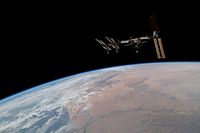
Short-exposure photo of the International Space Station (ISS) taken from Space Shuttle Atlantis in February 2008 during STS-122 – one of many photos taken in space where no stars are visible
-
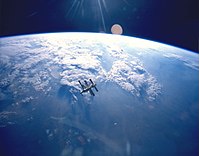
Earth and Mir in June 1995 – an example of how sunlight can outshine the stars, making them invisible
-
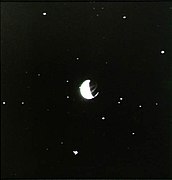
Long-exposure photo taken from the Moon’s surface by Apollo 16 astronauts using the Far Ultraviolet Camera/Spectrograph. It shows the Earth with the correct background of stars
-

Long-exposure photo (1.6 seconds at f/2.8, ISO 10000) from the ISS in July 2011 of Space Shuttle Atlantis re-entry in which some stars are visible. In this image, the Earth is lit by moonlight, not sunlight
5. The angle and color of shadows are inconsistent. This suggests that artificial lights were used.
- Shadows on the Moon are complicated by reflected light, uneven ground, wide-angle lens distortion, and lunar dust. There are several light sources: the Sun, sunlight reflected from the Earth, sunlight reflected from the Moon’s surface, and sunlight reflected from the astronauts and the Lunar Module. Light from these sources is scattered by lunar dust in many directions, including into shadows. Shadows falling into craters and hills may appear longer, shorter and distorted.[62] Furthermore, shadows display the properties of vanishing point perspective, leading them to converge to a point on the horizon.
- This theory was further debunked on the MythBusters episode “NASA Moon Landing”.
6. There are identical backgrounds in photos which, according to their captions, were taken miles apart. This suggests that a painted background was used.
- Backgrounds were not identical, just similar. What appear as nearby hills in some photos are actually mountains many miles away. On Earth, objects that are further away will appear fainter and less detailed. On the Moon, there is no atmosphere or haze to obscure faraway objects, thus they appear clearer and nearer.[63] Furthermore, there are very few objects (such as trees) to help judge distance. One such case is debunked in “Who Mourns For Apollo?” by Mike Bara.[64]
7. The number of photos taken is implausibly high. Up to one photo per 50 seconds.[65]
- Simplified gear with fixed settings allowed two photos a second. Many were taken immediately after each other as stereo pairs or panorama sequences. The calculation (one per 50 seconds) was based on a lone astronaut on the surface, and does not take into account that there were two astronauts sharing the workload and simultaneously taking photographs during an Extra-vehicular activity (EVA).
8. The photos contain artifacts like the two seemingly matching ‘C’s on a rock and on the ground. These may be labeled studio props.
- The “C”-shaped objects are most likely printing imperfections and do not appear in the original film from the camera. It has been suggested that the “C” is a coiled hair.[64][66]
-

Original AS16-107-17445 photograph
-
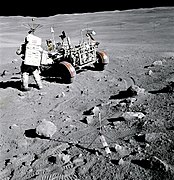
Original AS16-107-17446 photograph
-
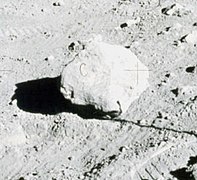
Close-up of later generation prints of AS16-107-17446
9. A resident of Perth, Western Australia, a woman named Una Ronald (a pseudonym created by the authors of the source[67]), said that for two or three seconds she saw a Coca-Cola bottle roll across the lower right quadrant of her television screen that was displaying the live broadcast of the Apollo 11 EVA. She also said that several letters appeared in The West Australian discussing the Coca-Cola bottle incident within ten days of the lunar landing.[68]
- No such newspaper reports or recordings have been found.[69] Ronald’s claims have only been relayed by one source.[70] There are also flaws in the story, e.g. the statement that she had to stay up late to watch the Moon landing live is easily discounted by many witnesses in Australia who watched the landing in the middle of their daytime.[71][72]
10. The book Moon Shot[73] contains an obviously fake composite photo of Alan Shepard hitting a golf ball on the Moon with another astronaut.
- It was used instead of the only existing real images, from the TV monitor, which the editors seemingly felt were too grainy for their book. The book publishers did not work for NASA.
11. There appear to be “hot spots” in some photos that look like a large spotlight was used in place of the Sun.
- Pits on the Moon’s surface focus and reflect light like the tiny glass spheres used in the coating of street signs, or dewdrops on wet grass. This creates a glow around the photographer’s own shadow when it appears in a photograph (see Heiligenschein).
- If the astronaut is standing in sunlight while photographing into shade, light reflected off his white spacesuit yields a similar effect to a spotlight.[74]
- Some widely published Apollo photos were high-contrast copies. Scans of the original transparencies are generally much more evenly lit. An example is shown below:
-
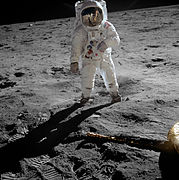
Original photo of Buzz Aldrin during Apollo 11
-
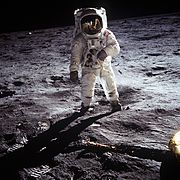
The more famous edited version. The contrast has been tweaked (yielding the “spotlight effect”) and a black band has been pasted at the top
12. Who filmed Neil Armstrong stepping onto the Moon?
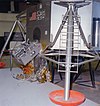
The Apollo TV camera as it was mounted on the side of the Lunar Module
- Cameras on the Lunar Module did. The Apollo TV camera mounted in the Modularized Equipment Stowage Assembly (MESA) of the Apollo Lunar Module gave a view from the exterior. While still on the Module’s ladder steps, Armstrong deployed the MESA from the side of the Lunar Module, unpacking, amongst other things, the TV camera. The TV camera was then powered on and a signal transmitted back to Earth. This meant that upwards of 600 million people on Earth could watch the live feed with only a very slight delay. Similar technology was also used on subsequent Apollo missions.[75][76][77][78] It was also filmed from an automatic 16mm movie camera mounted in a window of the Lunar Module.
Environment
1. The astronauts could not have survived the trip because of exposure to radiation from the Van Allen radiation belt and galactic ambient radiation (see radiation poisoning and health threat from cosmic rays). Some conspiracists have suggested that Starfish Prime (a high-altitude nuclear test in 1962) formed another intense layer on the Van Allen belt.[79]
- There are two main Van Allen belts – the inner belt and the outer belt – and a transient third belt.[80] The inner belt is the more dangerous one, containing energetic protons. The outer one has less-dangerous low-energy electrons (Beta particles).[81][82] The Apollo spacecraft passed through the inner belt in a matter of minutes and the outer belt in about 1 1⁄2 hours.[82] The astronauts were shielded from the ionizing radiation by the aluminum hulls of the spacecraft.[82][83] Furthermore, the orbital transfer trajectory from Earth to the Moon through the belts was chosen to lessen radiation exposure.[83] Even Dr. James Van Allen, the discoverer of the Van Allen belt, rebutted the claims that radiation levels were too harmful for the Apollo missions.[79] Philip Plait cited an average dose of less than 1 rem (10 mSv), which is equivalent to the ambient radiation received by living at sea level for three years.[84] The total radiation received on the trip was about the same as allowed for workers in the nuclear energy field for a year[82][85] and not much more than what Space Shuttle astronauts received.[81]
2. Film in the cameras would have been fogged by this radiation.
- The film was kept in metal containers that stopped radiation from fogging the film’s emulsion.[86] Furthermore, film carried by uncrewed lunar probes such as the Lunar Orbiter and Luna 3 (which used on-board film development processes) was not fogged.
3. The Moon’s surface during the daytime is so hot that camera film would have melted.
- There is no atmosphere to efficiently bind lunar surface heat to devices (such as cameras) that are not in direct contact with it. In a vacuum, only radiation remains as a heat transfer mechanism. The physics of radiative heat transfer are thoroughly understood, and the proper use of passive optical coatings and paints was enough to control the temperature of the film within the cameras; Lunar Module temperatures were controlled with similar coatings that gave them a gold color. Also, while the Moon’s surface does get very hot at lunar noon, every Apollo landing was made shortly after lunar sunrise at the landing site; the Moon’s day is about 29 1⁄2 Earth days long, meaning that one Moon day (dawn to dusk) lasts nearly fifteen Earth days. During the longer stays, the astronauts did notice increased cooling loads on their spacesuits as the sun and surface temperature continued to rise, but the effect was easily countered by the passive and active cooling systems.[87] The film was not in direct sunlight, so it was not overheated.[88]
4. The Apollo 16 crew could not have survived a big solar flare firing out when they were on their way to the Moon.
- No large solar flare occurred during the flight of Apollo 16. There were large solar flares in August 1972, after Apollo 16 returned to Earth and before the flight of Apollo 17.[89][90]
5. The flag placed on the surface by the astronauts fluttered despite there being no wind on the Moon. This suggests that it was filmed on Earth and a breeze caused the flag to flutter. Sibrel said that it may have been caused by indoor fans used to cool the astronauts since their spacesuit cooling systems would have been too heavy on Earth.
- The flag was fastened to a Г-shaped rod (see Lunar Flag Assembly) so that it did not hang down. The flag only seemed to flutter when the astronauts were moving it into position. Without air drag, these movements caused the free corner of the flag to swing like a pendulum for some time. The flag was rippled because it had been folded during storage – the ripples could be mistaken for movement in a still photo. Videos show that when the astronauts let go of the flagpole it vibrates briefly but then remains still.[91][92][93]
- This theory was further debunked on the MythBusters episode “NASA Moon Landing”.
-
Cropped photo of Buzz Aldrin saluting the flag (the fingers of Aldrin’s right hand can be seen behind his helmet)
-
Cropped photo taken a few seconds later, Buzz Aldrin’s hand is down, head turned toward the camera, the flag is unchanged
-
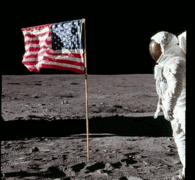
Animation of the two photos, showing that though Armstrong’s camera moved between exposures, the flag is not waving
6. Footprints in the Moondust are unexpectedly well preserved, despite the lack of moisture.
- Moondust has not been weathered like Earth sand and has sharp edges. This allows the dust particles to stick together and hold their shape in the vacuum. The astronauts likened it to “talcum powder or wet sand”.[64]
- This theory was further debunked on the MythBusters episode “NASA Moon Landing”.
7. The alleged Moon landings used either a sound stage or were filmed outside in a remote desert with the astronauts either using harnesses or slow-motion photography to make it look like they were on the Moon.
- While the HBO miniseries “From the Earth to the Moon”, and a scene from the movie “Apollo 13” used the sound-stage and harness setup, it is clearly seen from those films that when dust rose it did not quickly settle; some dust briefly formed clouds. In the film footage from the Apollo missions, dust kicked up by the astronauts’ boots and the wheels of the Lunar Roving Vehicles rose quite high due to the lower lunar gravity, and settled quickly to the ground in an uninterrupted parabolic arc since there was no air to suspend the dust. Even if there had been a sound stage for hoax Moon landings that had the air pumped out, the dust would have reached nowhere near the height and trajectory as in the Apollo film footage because of Earth’s greater gravity.
- During the Apollo 15 mission, David Scott did an experiment by dropping a hammer and a falcon feather at the same time. Both fell at the same rate and hit the ground at the same time. This proved that he was in a vacuum.[94]
- If the landings were filmed outside in a desert, heat waves would be present on the surface in mission videos, but no such heat waves exist in the footage. If the landings were filmed in a sound stage, several anomalies would occur, including a lack of parallax, and an increase or decrease in the size of the backdrop if the camera moved (footage was filmed while the rover was in motion, and yet no evidence of any change in the size of the background is present).
- This theory was further debunked on the MythBusters episode “NASA Moon Landing”.
-
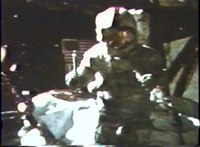 Play media
Play mediaDavid Scott drops a hammer and feather on the Moon
Mechanical issues
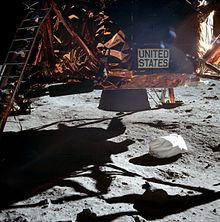
Lunar surface under the Lunar Module Eagle
1. The Lunar Modules made no blast craters or any sign of dust scatter.[95]
- No crater should be expected. The 4,500 kg (10,000 lb) thrust Descent Propulsion System was throttled very far down during the final landing.[96] The Lunar Module was no longer quickly decelerating, so the descent engine only had to support the lander’s own weight, which was lessened by the Moon’s gravity and by the near exhaustion of the descent propellants. At landing, the engine thrust divided by the nozzle exit area is only about 10 kPa (1.5 psi).[97][98]
Beyond the engine nozzle, the plume spreads, and the pressure drops very quickly. Rocket exhaust gasses expand much more quickly after leaving the engine nozzle in a vacuum than in an atmosphere. The effect of an atmosphere on rocket plumes can be easily seen in launches from Earth; as the rocket rises through the thinning atmosphere, the exhaust plumes broaden very noticeably. To lessen this, rocket engines made for vacuums have longer bells than those made for use on Earth, but they still cannot stop this spreading. The lander’s exhaust gasses, therefore, expanded quickly well beyond the landing site. The descent engines did scatter a lot of very fine surface dust as seen in 16mm movies of each landing, and many mission commanders spoke of its effect on visibility. The landers were generally moving horizontally as well as vertically, and photos do show scouring of the surface along the final descent path. Finally, the lunar regolith is very compact below its surface dust layer, making it impossible for the descent engine to blast out a “crater”.[99] A blast crater was measured under the Apollo 11 lander using shadow lengths of the descent engine bell and estimates of the amount that the landing gear had compressed and how deep the lander footpads had pressed into the lunar surface and it was found that the engine had eroded between 100 and 150 mm (4 and 6 in) of regolith out from underneath the engine bell during the final descent and landing.[100]
2. The second stage of the launch rocket and/or the Lunar Module ascent stage made no visible flame.
- The Lunar Modules used Aerozine 50 (fuel) and dinitrogen tetroxide (oxidizer) propellants, chosen for simplicity and reliability; they ignite hypergolically – upon contact – without the need for a spark. These propellants produce a nearly transparent exhaust.[101] The same fuel was used by the core of the American Titan II rocket. The transparency of their plumes is apparent in many launch photos. The plumes of rocket engines fired in a vacuum spread out very quickly as they leave the engine nozzle (see above), further lessening their visibility. Finally, rocket engines often run “rich” to slow internal corrosion. On Earth, the excess fuel burns in contact with atmospheric oxygen, enhancing the visible flame. This cannot happen in a vacuum.
-
 Play media
Play mediaApollo 17 LM leaving the Moon; rocket exhaust visible only briefly
-
 Play media
Play mediaApollo 8 launch through the first stage separation
-

Exhaust flame may not be visible outside the atmosphere, as in this photo. Rocket engines are the dark structures at the bottom center
-

The launch of a Titan II, burning hypergolic Aerozine-50/N2O4, 1.9 MN (430,000 lbf) of thrust. Note the near-transparency of the exhaust, even in air (water is being sprayed up from below)
-

Atlas uses non-hypergolic kerosene (RP-1) fuel which gives a bright and very visible exhaust, 1.5 MN (340,000 lbf) of thrust
-

Bright flame from first stage of the Saturn V, burning RP-1
3. The Lunar Modules weighed 17 tons and made no mark on the Moondust, yet footprints can be seen beside them.[102]
- On the surface of the Earth, Apollo 11’s fueled and crewed Lunar Module. Eagle, would have weighed approximately 15,000 kg (17 short tons). On the surface of the Moon, however, after expending fuel and oxidizer on its descent from lunar orbit, the lander weighed about 1,200 kg (2,700 pounds).[103] The astronauts were much lighter than the lander, but their boots were much smaller than the lander’s approximately 91 cm (3 ft) diameter footpads.[104] Pressure (or force per unit area) rather than mass determines the amount of regolith compression. In some photos, the footpads did press into the regolith, especially when they moved sideways at touchdown. (The bearing pressure under Apollo 11’s footpads, with the lander being about 44 times the weight of an EVA-configured astronaut, would have been of similar magnitude to the bearing pressure exerted by the astronauts’ boots.)[105]
4. The air conditioning units that were part of the astronauts’ spacesuits could not have worked in an environment of no atmosphere.[106]
- The cooling units could only work in a vacuum. Water from a tank in the backpack flowed out through tiny pores in a metal sublimator plate where it quickly vaporized into space. The loss of the heat of vaporization froze the remaining water, forming a layer of ice on the outside of the plate that also sublimated into space (turning from a solid directly into a gas). A separate water loop flowed through the LCG (Liquid Cooling Garment) worn by the astronaut, carrying his metabolic waste heat through the sublimator plate where it was cooled and returned to the LCG. Five point four kg (12 lb) of feedwater gave about eight hours of cooling; because of its bulk, it was often the limiting consumable on the length of an EVA.

Surveyor 3 with Apollo 12 lander in background
Transmissions
1. There should have been more than a two-second delay in communications between Earth and the Moon, at a distance of 400,000 km (250,000 miles).
- The round trip light travel time of more than two seconds is apparent in all the real-time recordings of the lunar audio, but this does not always appear as expected. There may also be some documentary films where the delay has been edited out. Reasons for editing the audio may be time constraints or in the interest of clarity.[107]
2. Typical delays in communication were about 0.5 seconds.
- Claims that the delays were only half a second are untrue, as examination of the original recordings shows. Also, there should not be a consistent time delay between every response, as the conversation is being recorded at one end – Mission Control. Responses from Mission Control could be heard without any delay, as the recording is being made at the same time that Houston receives the transmission from the Moon.
3. The Parkes Observatory in Australia was billed to the world for weeks as the site that would be relaying communications from the first moonwalk. However, five hours before transmission they were told to stand down.
- The timing of the first moonwalk was changed after the landing. In fact, delays in getting the moonwalk started meant that Parkes did cover almost the entire Apollo 11 moonwalk.[108]
4. Parkes supposedly had the clearest video feed from the Moon, but Australian media and all other known sources ran a live feed from the United States.
- While that was the original plan, and, according to some sources, the official policy, the Australian Broadcasting Commission (ABC) did take the transmission direct from the Parkes and Honeysuckle Creek radio telescopes. These were converted to NTSC television at Paddington, in Sydney. This meant that Australian viewers saw the moonwalk several seconds before the rest of the world.[109] See also Parkes radio astronomer John Sarkissian’s article, “On Eagle’s Wings: The Parkes Observatory’s Support of the Apollo 11 Mission”[110] The events surrounding the Parkes Observatory’s role in relaying the live television of the moonwalk were portrayed in a slightly fictionalized Australian film comedy “The Dish” (2000).
5. Better signal was supposedly received at Parkes Observatory when the Moon was on the opposite side of the planet.
- This is not supported by the detailed evidence and logs from the missions.[111]
Missing data
Blueprints and design and development drawings of the machines involved are missing.[112][113] Apollo 11 data tapes containing telemetry and the high-quality video (before scan conversion from slow-scan TV to standard TV) of the first moonwalk are also missing.[114][115]
Tapes
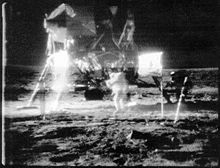
Photo of the high-quality SSTV image before the scan conversion
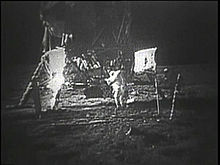
Photo of the degraded image after the SSTV scan conversion
Dr. David R. Williams (NASA archivist at Goddard Space Flight Center) and Apollo 11 flight director Eugene F. Kranz both acknowledged that the original high-quality Apollo 11 telemetry data tapes are missing. Conspiracists see this as evidence that they never existed.[114] The Apollo 11 telemetry tapes were different from the telemetry tapes of the other Moon landings because they contained the raw television broadcast. For technical reasons, the Apollo 11 lander carried a slow-scan television (SSTV) camera (see Apollo TV camera). To broadcast the pictures to regular television, a scan conversion had to be done. The radio telescope at Parkes Observatory in Australia was able to receive the telemetry from the Moon at the time of the Apollo 11 moonwalk.[110] Parkes had a bigger antenna than NASA’s antenna in Australia at the Honeysuckle Creek Tracking Station, so it received a better picture. It also received a better picture than NASA’s antenna at Goldstone Deep Space Communications Complex. This direct TV signal, along with telemetry data, was recorded onto one-inch fourteen-track analog tape at Parkes. The original SSTV transmission had better detail and contrast than the scan-converted pictures, and it is this original tape that is missing.[116] A crude, real-time scan conversion of the SSTV signal was done in Australia before it was broadcast worldwide. However, still photos of the original SSTV image are available (see photos). About fifteen minutes of it were filmed by an amateur 8 mm film camera and these are also available. Later Apollo missions did not use SSTV. At least some of the telemetry tapes from the ALSEP scientific experiments left on the Moon (which ran until 1977) still exist, according to Dr. Williams. Copies of those tapes have been found.[117]
Others are looking for the missing telemetry tapes for different reasons. The tapes contain the original and highest quality video feed from the Apollo 11 landing. Some former Apollo personnel want to find the tapes for posterity while NASA engineers looking towards future Moon missions believe the tapes may be useful for their design studies. They have found that the Apollo 11 tapes were sent for storage at the U.S. National Archives in 1970, but by 1984, all the Apollo 11 tapes had been returned to the Goddard Space Flight Center at their request. The tapes are believed to have been stored rather than re-used.[118] Goddard was storing 35,000 new tapes per year in 1967,[119] even before the Moon landings.
In November 2006, COSMOS Online reported that about 100 data tapes recorded in Australia during the Apollo 11 mission had been found in a small marine science laboratory in the main physics building at the Curtin University of Technology in Perth, Australia. One of the old tapes has been sent to NASA for analysis. The slow-scan television images were not on the tape.[117]
In July 2009, NASA indicated that it must have erased the original Apollo 11 Moon footage years ago so that it could re-use the tape. In December 2009 NASA issued a final report on the Apollo 11 telemetry tapes.[120] Senior engineer Dick Nafzger, who was in charge of the live TV recordings during the Apollo missions, was put in charge of the restoration project. After a three-year search, the “inescapable conclusion” was that about 45 tapes (estimated 15 tapes recorded at each of the three tracking stations) of Apollo 11 video were erased and re-used, said Nafzger.[121] In time for the 40th anniversary of the Apollo 11 landing, Lowry Digital had been tasked with restoring the surviving footage. Lowry Digital president Mike Inchalik said that, “this is by far and away the lowest quality” video the company has dealt with. Nafzger praised Lowry for restoring “crispness” to the Apollo video, which will remain in black and white and contains conservative digital enhancements. The US$230,000 restoration project took months to complete and did not include sound quality improvements. Some selections of restored footage in high-definition have been made available on the NASA website.[122]
Blueprints
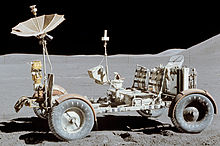
Lunar Roving Vehicle flown on Apollo 15
Grumman appears to have destroyed most of their LM documentation,[113][123] but copies of the blueprints for the Saturn V exist on microfilm.[124]
Four mission-worthy Lunar Roving Vehicles (LRV) were built by Boeing.[125] Three of them were carried to the Moon on Apollos 15, 16, and 17, used by the astronauts for transportation once on the Moon, and left there. After Apollo 18 was canceled, the other LRV was used for spare parts for the Apollos 15 to 17 missions. The 221-page operation manual for the LRV contains some detailed drawings,[126] although not the blueprints.
NASA technology compared to USSR
Bart Sibrel cites the relative level of the United States and USSR space technology as evidence that the Moon landings could not have happened. For much of the early stages of the Space Race, the USSR was ahead of the United States, yet in the end, the USSR was never able to fly a crewed spacecraft to the Moon, let alone land one on the surface. It is argued that, because the USSR was unable to do this, the United States should have also been unable to develop the technology to do so.
For example, he claims that, during the Apollo program, the USSR had five times more crewed hours in space than the United States, and notes that the USSR was the first to achieve many of the early milestones in space: the first artificial satellite in orbit (October 1957, Sputnik 1);[d] the first living creature in orbit (a dog named Laika, November 1957, Sputnik 2); the first man in space and in orbit (Yuri Gagarin, April 1961, Vostok 1); the first woman in space (Valentina Tereshkova, June 1963, Vostok 6); and the first spacewalk (Alexei Leonov in March 1965, Voskhod 2).
However, most of the Soviet gains listed above were matched by the United States within a year, and sometimes within weeks. In 1965, the United States started to achieve many firsts (such as the first successful space rendezvous), which were important steps in a mission to the Moon. Furthermore, NASA and others say that these gains by the Soviets are not as impressive as they seem; that a number of these firsts were mere stunts that did not advance the technology greatly, or at all, e.g., the first woman in space.[127][128] In fact, by the time of the launch of the first crewed Earth-orbiting Apollo flight (Apollo 7), the USSR had made only nine spaceflights (seven with one cosmonaut, one with two, one with three) compared to 16 by the United States. In terms of spacecraft hours, the USSR had 460 hours of spaceflight; the United States had 1,024 hours. In terms of astronaut/cosmonaut time, the USSR had 534 hours of crewed spaceflight whereas the United States had 1,992 hours. By the time of Apollo 11, the United States had a lead much wider than that. (See List of human spaceflights, 1961–1970, and refer to individual flights for the length of time.)
Moreover, the USSR did not develop a successful rocket capable of a crewed lunar mission until the 1980s – their N1 rocket failed on all four launch attempts between 1969 and 1972.[129] The Soviet LK lunar lander was tested in uncrewed low-Earth-orbit flights three times in 1970 and 1971.
Technology used by NASA
The digital technology on Earth during the time of the Moon landings was just in its infancy. The astronauts had relied on computers to aid in the Moon missions. The Apollo Guidance Computer was on the Lunar Module and the command and service module. Many computers at the time were very large despite poor specs.[130][131] For example, in 1973, one year after the final Moon landing, the Xerox Alto was released.[132] This computer had 96kB of memory.[133] Most personal computers as of 2019, use 50,000 – 100,000 times this amount of RAM.[134] Conspiracy theorists claim that the computers during the time of the Moon landings would not have been advanced enough to allow for human space travel to the Moon and back;[135] they similarly claim that other contemporary technology (radio transmission, radar, and other instrumentation) was likewise insufficient for the task.[136]
Deaths of NASA personnel
In a televised program about the moon-landing hoax allegations, Fox Entertainment Group listed the deaths of ten astronauts and two civilians related to the crewed spaceflight program as part of an alleged cover-up.
- Theodore Freeman (killed ejecting from a T-38 which had suffered a bird strike, October 1964)
- Elliot See and Charlie Bassett (T-38 crash in bad weather, February 1966)
- Virgil “Gus” Grissom, Ed White, and Roger B. Chaffee (killed in a fire during the “plugs-out test” preceding Apollo 1, January 1967)
- Edward “Ed” Givens (killed in a car accident, June 1967)
- Clifton “C. C.” Williams (killed ejecting from a T-38, October 1967)
- Michael J. “Mike” Adams (died in an X-15 crash, November 1967. Adams was the only pilot killed during the X-15 flight test program. He was a test pilot, not a NASA astronaut, but had flown the X-15 above 80 kilometres or 50 miles)
- Robert Henry Lawrence, Jr. (killed in an F-104 crash, December 1967, shortly after being selected as a pilot with the United States Air Force’s Manned Orbiting Laboratory (MOL) program, which was canceled in 1969)
- Thomas Ronald Baron (North American Aviation employee. Baron died in an automobile collision with a train, April 27, 1967, six days after testifying before Rep. Olin E. Teague’s House Subcommittee on NASA Oversight hearings held following the Apollo 1 fire, after which he was fired)
- Brian D. Welch (leading official in NASA’s Public Affairs Office and Director of Media Services)
Two of the above, X-15 pilot Mike Adams and MOL pilot Robert Lawrence, had no connection with the civilian crewed space program that oversaw the Apollo missions. Baron was a quality control inspector who wrote a report critical of the Apollo program and was an outspoken critic of NASA’s safety record after the Apollo 1 fire. Baron and his family were killed as their car was struck by a train at a train crossing. The deaths were an accident.[137][138] Welch died a few months after appearing in the media to debunk the pro-hoax television show cited above.[139] All of the deaths listed besides Welch occurred at least 20 months before Apollo 11 and subsequent flights.
As of November 2018[update], four of the twelve Apollo astronauts who landed on the Moon between 1969 and 1972 are still alive, including Buzz Aldrin. Also, seven of the twelve Apollo astronauts who flew to the Moon without landing between 1968 and 1972 are still alive, including Michael Collins.
The number of deaths within the American astronaut corps during the run-up to Apollo and during the Apollo missions is similar to the number of deaths incurred by the Russians. During the period 1961 to 1972, at least eight Russian serving and former cosmonauts died:
- Valentin Bondarenko (ground training accident, March 1961)
- Grigori Nelyubov (suicide, February 1966)
- Vladimir Komarov (Soyuz 1 accident, April 1967)
- Yuri Gagarin (MiG-15 crash, March 1968)
- Pavel Belyayev (complications following surgery, January 1970)
- Georgi Dobrovolski, Vladislav Volkov, and Viktor Patsayev (Soyuz 11 accident, June 1971)
Additionally, the overall chief of their crewed-spaceflight program, Sergei Korolev, died while undergoing surgery in January 1966.
NASA response
In June 1977, NASA issued a fact sheet responding to recent claims that the Apollo Moon landings had been hoaxed.[140] The fact sheet is particularly blunt and regards the idea of faking the Moon landings to be preposterous and outlandish. NASA refers to the rocks and particles collected from the Moon as being evidence of the program’s legitimacy, as they claim that these rocks could not have been formed under conditions on earth. NASA also notes that all of the operations and phases of the Apollo program were closely followed and under the scrutiny of the news media, from liftoff to splashdown. NASA responds to Bill Kaysing’s book, We Never Went to the Moon, by identifying one of his claims of fraud regarding the lack of a crater left on the Moon’s surface by the landing of the lunar module, and refuting it with facts about the soil and cohesive nature of the surface of the Moon.
The fact sheet was reissued on February 14, 2001, the day before Fox television’s broadcast of Conspiracy Theory: Did We Land on the Moon? The documentary reinvigorated the public’s interest in conspiracy theories and the possibility that the Moon landings were faked, which has provoked NASA to once again defend its name.
Alleged Stanley Kubrick involvement
Filmmaker Stanley Kubrick is accused of having produced much of the footage for Apollos 11 and 12, presumably because he had just directed 2001: A Space Odyssey, which is partly set on the Moon and featured advanced special effects.[141] It has been claimed that when 2001 was in post-production in early 1968, NASA secretly approached Kubrick to direct the first three Moon landings. The launch and splashdown would be real but the spacecraft would stay in Earth orbit and fake footage broadcast as “live from the Moon.” No evidence was offered for this theory, which overlooks many facts. For example, 2001 was released before the first Apollo landing and Kubrick’s depiction of the Moon’s surface differs greatly from its appearance in the Apollo footage. The movement of characters on the Moon in 2001 differs from that of the filmed movement of Apollo astronauts, and does not resemble an environment with 1/6 the gravity of Earth. Several scenes in 2001 show dust billowing as spacecraft landed, something that would not happen in the vacuum environment of the Moon. Kubrick did hire Frederick Ordway and Harry Lange, both of whom had worked for NASA and major aerospace contractors, to work with him on 2001. Kubrick also used some 50 mm f/0.7 lenses that were left over from a batch made by Zeiss for NASA. However, Kubrick only got this lens for Barry Lyndon (1975). The lens was originally a still photo lens and needed changes to be used for motion filming.
The mockumentary based on this idea, Dark Side of the Moon, could have fueled the conspiracy theory. This French mockumentary, directed by William Karel, was originally aired on Arte channel in 2002 with the title Opération Lune. It parodies conspiracy theories with faked interviews, stories of assassinations of Stanley Kubrick’s assistants by the CIA, and a variety of conspicuous mistakes, puns, and references to old movie characters, inserted through the film as clues for the viewer. Nevertheless, Opération Lune is still taken at face value by some conspiracy believers.
An article titled “Stanley Kubrick and the Moon Hoax” appeared on Usenet in 1995, in the newsgroup “alt.humor.best-of-usenet”. One passage – on how Kubrick was supposedly coerced into the conspiracy – reads:
NASA further leveraged their position by threatening to publicly reveal the heavy involvement of Mr. Kubrick’s younger brother, Raul, with the American Communist Party. This would have been an intolerable embarrassment to Mr. Kubrick, especially since the release of Dr. Strangelove.
Kubrick had no such brother – the article was a spoof, complete with a giveaway sentence describing Kubrick shooting the moonwalk “on location” on the Moon. Nevertheless, the claim was taken up in earnest;[142] Clyde Lewis used it almost word-for-word,[141] whereas Jay Weidner gave the brother a more senior status within the party:
No one knows how the powers-that-be convinced Kubrick to direct the Apollo landings. Maybe they had compromised Kubrick in some way. The fact that his brother, Raul Kubrick, was the head of the American Communist Party may have been one of the avenues pursued by the government to get Stanley to cooperate.[143]
In July 2009, Weidner posted on his webpage “Secrets of the Shining”, where he states that Kubrick’s The Shining (1980) is a veiled confession of his role in the scam project.[144][145] This thesis was the subject of refutation in an article published on Seeker nearly half a year later.[146]
The 2015 movie Moonwalkers is a fictional account of a CIA agent’s claim of Kubrick’s involvement.
In December 2015, a video surfaced which allegedly shows Kubrick being interviewed shortly before his 1999 death; the video purportedly shows the director confessing to T. Patrick Murray that the Apollo Moon landings had been faked.[147] Research quickly found, however, that the video was a hoax.[148]
Academic work
In 2002, NASA granted US$15,000 to James Oberg for a commission to write a point-by-point rebuttal of the hoax claims. However, NASA canceled the commission later that year, after complaints that the book would dignify the accusations.[139] Oberg said that he meant to finish the book.[139][149] In November 2002, Peter Jennings said “NASA is going to spend a few thousand dollars trying to prove to some people that the United States did indeed land men on the Moon,” and “NASA had been so rattled, [they] hired [somebody] to write a book refuting the conspiracy theorists.” Oberg says that belief in the hoax theories is not the fault of the conspiracists, but rather that of teachers and people (including NASA) who should provide information to the public.[139]
In 2004, Martin Hendry and Ken Skeldon of the University of Glasgow were awarded a grant by the UK-based Particle Physics and Astronomy Research Council to investigate Moon landing conspiracy theories.[150] In November 2004, they gave a lecture at the Glasgow Science Centre where the top ten claims by conspiracists were individually addressed and refuted.[151]
MythBusters special
An episode of MythBusters in August 2008 was dedicated to the Moon landings. The MythBusters crew tested many of the conspiracists’ claims. Some of the testings were done in a NASA training facility. All of the conspiracists’ claims examined on the show were labeled as having been “Busted”, meaning that the conspiracists’ claims were not true.
Third-party evidence of Moon landings
Imaging the landing sites
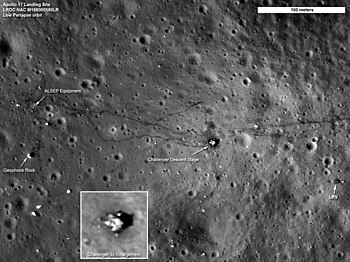
Lunar Reconnaissance Orbiter photo of Apollo 17 landing site (click to enlarge)[2]
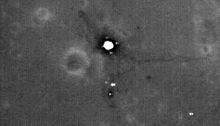
Apollo 11 landing site – “There the lunar module sits, parked just where it landed 40 years ago, as if it still really were 40 years ago and all the time since merely imaginary.” –The New York Times[152]
Moon-landing conspiracists claim that observatories and the Hubble Space Telescope should be able to photograph the landing sites. This implies that the world’s major observatories (as well as the Hubble Program) are complicit in the hoax by refusing to take photos of the landing sites. Photos of the Moon have been taken by Hubble, including at least two Apollo landing sites, but the Hubble resolution limits viewing of lunar objects to sizes no smaller than 55–69 m (60–75 yd), which is insufficient resolution to see any landing site features.[153]
In April 2001, Leonard David published an article on space.com,[154][155] which showed a photo taken by the Clementine mission showing a diffuse dark spot at the site NASA says is the Apollo 15 lander. The evidence was noticed by Misha Kreslavsky, of the Department of Geological Sciences at Brown University, and Yuri Shkuratov of the Kharkiv Astronomical Observatory in Ukraine. The European Space Agency’s SMART-1 uncrewed probe sent back photos of the landing sites, according to Bernard Foing, Chief Scientist of the ESA Science Program.[156] “Given SMART-1’s initial high orbit, however, it may prove difficult to see artifacts,” said Foing in an interview on space.com.
In 2002, Alex R. Blackwell of the University of Hawaii pointed out that some photos taken by Apollo astronauts[155] while in orbit around the Moon show the landing sites.
The Daily Telegraph published a story in 2002 saying that European astronomers at the Very Large Telescope (VLT) would use it to view the landing sites. According to the article, Dr. Richard West said that his team would take “a high-resolution image of one of the Apollo landing sites.” Marcus Allen, a conspiracist, answered that no photos of hardware on the Moon would convince him that human landings had happened.[157] The telescope was used to image the Moon and provided a resolution of 130 meters (430 ft), which was not good enough to resolve the 4.2 meters (14 ft) wide lunar landers or their long shadows.[158]
The Japan Aerospace Exploration Agency (JAXA) launched their SELENE Moon orbiter on September 14, 2007 (JST), from Tanegashima Space Center. SELENE orbited the Moon at about 100 km (62 miles) altitude. In May 2008, JAXA reported detecting the “halo” generated by the Apollo 15 Lunar Module engine exhaust from a Terrain Camera image.[159] A three-dimensional reconstructed photo also matched the terrain of an Apollo 15 photo taken from the surface.
On July 17, 2009, NASA released low-resolution engineering test photos of the Apollo 11, Apollo 14, Apollo 15, Apollo 16 and Apollo 17 landing sites that have been photographed by the Lunar Reconnaissance Orbiter as part of the process of starting its primary mission.[160] The photos show the descent stage of the landers from each mission on the Moon’s surface. The photo of the Apollo 14 landing site also shows tracks made by an astronaut between a science experiment (ALSEP) and the lander.[160] Photos of the Apollo 12 landing site were released by NASA on September 3, 2009.[161] The Intrepid lander descent stage, experiment package (ALSEP), Surveyor 3 spacecraft, and astronaut footpaths are all visible. While the LRO images have been enjoyed by the scientific community as a whole, they have not done anything to convince conspiracists that the landings happened.[162]
On September 1, 2009, India’s lunar mission Chandrayaan-1 took photos of the Apollo 15 landing site and tracks of the lunar rovers.[163][164] The Indian Space Research Organisation launched their uncrewed lunar probe on September 8, 2008 (IST), from Satish Dhawan Space Centre. The photos were taken by a hyperspectral camera fitted as part of the mission’s image payload.[163]
China’s second lunar probe, Chang’e 2, which was launched in 2010, can photograph the lunar surface with a resolution of up to 1.3 m (4.3 ft). It spotted traces of the Apollo landings.[165]
Moon rocks
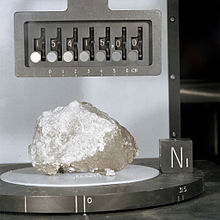
Genesis Rock brought back by Apollo 15 – older than any rocks on Earth
The Apollo program collected 380 kg (838 lb) of Moon rocks during the six crewed missions. Analyses by scientists worldwide all agree that these rocks came from the Moon – no published accounts in peer-reviewed scientific journals exist that dispute this claim. The Apollo samples are easily distinguishable from both meteorites and Earth rocks[6] in that they show a lack of hydrous alteration products, they show evidence of having undergone impact events on an airless body, and they have unique geochemical traits. Furthermore, most are more than 200 million years older than the oldest Earth rocks. The Moon rocks also share the same traits as Soviet samples.[166]
Conspiracists argue that Marshall Space Flight Center Director Wernher von Braun’s trip to Antarctica in 1967 (about two years before the Apollo 11 launch) was to gather lunar meteorites to be used as fake Moon rocks. Because von Braun was a former SS officer (though one who had been detained by the Gestapo),[167] the documentary film Did We Go?[114] suggests that he could have been pressured to agree to the conspiracy to protect himself from recriminations over his past. NASA said that von Braun’s mission was “to look into environmental and logistic factors that might relate to the planning of future space missions, and hardware.”[168] NASA continues to send teams to work in Antarctica to mimic the conditions on other planets.
It is now accepted by the scientific community that rocks have been blasted from both the Martian and lunar surface during impact events, and that some of these have landed on the Earth as meteorites.[169][170] However, the first Antarctic lunar meteorite was found in 1979, and its lunar origin was not recognized until 1982.[171] Furthermore, lunar meteorites are so rare that it is unlikely that they could account for the 380 kg (840 lb) of Moon rocks that NASA gathered between 1969 and 1972. Only about 30 kg (66 lb) of lunar meteorites have been found on Earth thus far, despite private collectors and governmental agencies worldwide searching for more than 20 years.[171]
While the Apollo missions gathered 380 kg (840 lb) of Moon rocks, the Soviet Luna 16, Luna 20 and Luna 24 robots gathered only 326 g (11.5 oz) combined (that is, less than one-thousandth as much). Indeed, current plans for a Martian sample return would only gather about 500 g (18 oz) of soil,[172] and a recently proposed South Pole-Aitken basin robot mission would only gather about 1 kg (2.2 lb) of Moon rock.[173][174][175] If NASA had used similar robot technology, then between 300 and 2,000 robot missions would have been needed to collect the current amount of Moon rocks that is held by NASA.
On the makeup of the Moon rocks, Kaysing asked: “Why was there never a mention of gold, silver, diamonds or other precious metals on the moon? Wasn’t this a viable consideration? Why was this fact never dicussed [sic] in the press or by the astronauts?”[176] Geologists realize that gold and silver deposits on Earth are the result of the action of hydrothermal fluids concentrating the precious metals into veins of ore. Since in 1969 water was believed to be absent on the Moon, no geologist discussed finding these on the Moon in any great amount.
Missions tracked by independent parties
Aside from NASA, a number of groups and individuals tracked the Apollo missions as they happened. On later missions, NASA released information to the public explaining where and when the spacecraft could be sighted. Their flight paths were tracked using radar and they were sighted and photographed using telescopes. Also, radio transmissions between the astronauts on the surface and in orbit were independently recorded.
Retroreflectors

Apollo 11 retroreflector, still with its protective cover
The presence of retroreflectors (mirrors used as targets for Earth-based tracking lasers) from the Laser Ranging Retroreflector Experiment (LRRR) is evidence that there were landings.[177] Lick Observatory attempted to detect from Apollo 11’s retroreflector while Armstrong and Aldrin were still on the Moon but did not succeed until August 1, 1969.[178] The Apollo 14 astronauts deployed a retroreflector on February 5, 1971, and McDonald Observatory detected it the same day. The Apollo 15 retroreflector was deployed on July 31, 1971, and was detected by McDonald Observatory within a few days.[179] Smaller retroreflectors were also put on the Moon by the Russians; they were attached to the uncrewed lunar rovers Lunokhod 1 and Lunokhod 2.[180]
Public opinion
In a 1994 poll by The Washington Post, 9% of the respondents said that it was possible that astronauts did not go to the Moon and another 5% were unsure.[181] A 1999 Gallup Poll found that 6% of the Americans surveyed doubted that the Moon landings happened and that 5% of those surveyed had no opinion,[182][183][184][185] which roughly matches the findings of a similar 1995 Time/CNN poll.[182] Officials of the Fox network said that such skepticism rose to about 20% after the February 2001 airing of their network’s television special, Conspiracy Theory: Did We Land on the Moon?, seen by about 15 million viewers.[183] This Fox special is seen as having promoted the hoax claims.[186][187]
A 2000 poll conducted by the Public Opinion Foundation [ru] (ФОМ) in Russia found that 28% of those surveyed did not believe that American astronauts landed on the Moon, and this percentage is roughly equal in all social-demographic groups.[188][189][190] In 2009, a poll held by the United Kingdom’s Engineering & Technology magazine found that 25% of those surveyed did not believe that men landed on the Moon.[191] Another poll gives that 25% of 18- to 25-year-olds surveyed were unsure that the landings happened.[192]
There are subcultures worldwide which advocate the belief that the Moon landings were faked. By 1977 the Hare Krishna magazine Back to Godhead called the landings a hoax, claiming that, since the Sun is 150 million km (93 million mi) away, and “according to Hindu mythology the Moon is 800,000 miles [1,300,000 km] farther away than that”, the Moon would be nearly 151 million km (94 million mi) away; to travel that span in 91 hours would require a speed of more than a million miles per hour, “a patently impossible feat even by the scientists’ calculations.”[193][194]
James Oberg of ABC News said that the conspiracy theory is taught in Cuban schools and wherever Cuban teachers are sent.[139][195] A poll conducted in the 1970s by the United States Information Agency in several countries in Latin America, Asia, and Africa found that most respondents were unaware of the Moon landings, many of the others dismissed them as propaganda or science fiction, and many thought that it had been the Russians that landed on the Moon.[196]
In 2019, Ipsos conducted a study for C-Span to assess the level of belief that the 1969 Moon landing was faked. Six percent of respondents believed it was not real, but 11% of millennials (reached adulthood in the early 21st Century) were the most likely to believe it was not factual.[197]
See also
.mw-parser-output .portal{border:solid #aaa 1px;padding:0}.mw-parser-output .portal.tleft{margin:0.5em 1em 0.5em 0}.mw-parser-output .portal.tright{margin:0.5em 0 0.5em 1em}.mw-parser-output .portal>ul{display:table;box-sizing:border-box;padding:0.1em;max-width:175px;background:#f9f9f9;font-size:85%;line-height:110%;font-style:italic;font-weight:bold}.mw-parser-output .portal>ul>li{display:table-row}.mw-parser-output .portal>ul>li>span:first-child{display:table-cell;padding:0.2em;vertical-align:middle;text-align:center}.mw-parser-output .portal>ul>li>span:last-child{display:table-cell;padding:0.2em 0.2em 0.2em 0.3em;vertical-align:middle}
 Spaceflight portal
Spaceflight portal Solar System portal
Solar System portal
- Astronauts Gone Wild – 2004 conspiracy theory film by Bart Sibrel
- In the Shadow of the Moon – 2007 film by Christopher Riley, David Sington
- Lost Cosmonauts – Conspiracy theory about Soviet cosmonauts
- List of topics characterized as pseudoscience – Wikipedia list article
- Stolen and missing Moon rocks – Summary of lunar material samples stolen or misplaced
- Great Moon Hoax – Fake newspaper article series
Notes
- ^ In 1968, Clarke and Kubrick had collaborated on the film 2001: A Space Odyssey, which realistically portrayed a Moon mission.
- ^ He does this in his site as well
- ^ This number includes the crews of Apollos 8, 10, and 13, though the latter technically only performed a fly-by. These three missions account for only six additional astronauts because James Lovell orbited the Moon twice (Apollos 8 and 13) and John Young and Gene Cernan orbited on Apollo 10 both later landed on the Moon.
- ^ According to the 2007 NOVA episode “Sputnik Declassified,” the United States could have launched the Explorer 1 probe before Sputnik, but the Eisenhower administration hesitated, first because they were not sure if international law meant that national borders kept going all the way into orbit (and, thus, their orbiting satellite could cause an international uproar by violating the borders of dozens of nations), and second because there was a desire to see the not yet ready Vanguard satellite program, designed by American citizens, become America’s first satellite rather than the Explorer program, that was mostly designed by former rocket designers from Nazi Germany. A transcript of the appropriate section from the show is available at “Sputnik’s Impact on America.”
Citations
![]() This article incorporates public domain material from websites or documents of the National Aeronautics and Space Administration.
This article incorporates public domain material from websites or documents of the National Aeronautics and Space Administration.
- ^ Plait 2002, pp. 154–173
- ^ a b Neal-Jones, Nancy; Zubritsky, Elizabeth; Cole, Steve (September 6, 2011). Garner, Robert (ed.). “NASA Spacecraft Images Offer Sharper Views of Apollo Landing Sites”. NASA. Goddard Release No. 11-058 (co-issued as NASA HQ Release No. 11-289). Retrieved September 22, 2011.
.mw-parser-output cite.citation{font-style:inherit}.mw-parser-output .citation q{quotes:”””””””‘””‘”}.mw-parser-output .id-lock-free a,.mw-parser-output .citation .cs1-lock-free a{background-image:url(“//upload.wikimedia.org/wikipedia/commons/thumb/6/65/Lock-green.svg/9px-Lock-green.svg.png”);background-image:linear-gradient(transparent,transparent),url(“//upload.wikimedia.org/wikipedia/commons/6/65/Lock-green.svg”);background-repeat:no-repeat;background-size:9px;background-position:right .1em center}.mw-parser-output .id-lock-limited a,.mw-parser-output .id-lock-registration a,.mw-parser-output .citation .cs1-lock-limited a,.mw-parser-output .citation .cs1-lock-registration a{background-image:url(“//upload.wikimedia.org/wikipedia/commons/thumb/d/d6/Lock-gray-alt-2.svg/9px-Lock-gray-alt-2.svg.png”);background-image:linear-gradient(transparent,transparent),url(“//upload.wikimedia.org/wikipedia/commons/d/d6/Lock-gray-alt-2.svg”);background-repeat:no-repeat;background-size:9px;background-position:right .1em center}.mw-parser-output .id-lock-subscription a,.mw-parser-output .citation .cs1-lock-subscription a{background-image:url(“//upload.wikimedia.org/wikipedia/commons/thumb/a/aa/Lock-red-alt-2.svg/9px-Lock-red-alt-2.svg.png”);background-image:linear-gradient(transparent,transparent),url(“//upload.wikimedia.org/wikipedia/commons/a/aa/Lock-red-alt-2.svg”);background-repeat:no-repeat;background-size:9px;background-position:right .1em center}.mw-parser-output .cs1-subscription,.mw-parser-output .cs1-registration{color:#555}.mw-parser-output .cs1-subscription span,.mw-parser-output .cs1-registration span{border-bottom:1px dotted;cursor:help}.mw-parser-output .cs1-ws-icon a{background-image:url(“//upload.wikimedia.org/wikipedia/commons/thumb/4/4c/Wikisource-logo.svg/12px-Wikisource-logo.svg.png”);background-image:linear-gradient(transparent,transparent),url(“//upload.wikimedia.org/wikipedia/commons/4/4c/Wikisource-logo.svg”);background-repeat:no-repeat;background-size:12px;background-position:right .1em center}.mw-parser-output code.cs1-code{color:inherit;background:inherit;border:inherit;padding:inherit}.mw-parser-output .cs1-hidden-error{display:none;font-size:100%}.mw-parser-output .cs1-visible-error{font-size:100%}.mw-parser-output .cs1-maint{display:none;color:#33aa33;margin-left:0.3em}.mw-parser-output .cs1-subscription,.mw-parser-output .cs1-registration,.mw-parser-output .cs1-format{font-size:95%}.mw-parser-output .cs1-kern-left,.mw-parser-output .cs1-kern-wl-left{padding-left:0.2em}.mw-parser-output .cs1-kern-right,.mw-parser-output .cs1-kern-wl-right{padding-right:0.2em}.mw-parser-output .citation .mw-selflink{font-weight:inherit} - ^ Robinson, Mark (July 27, 2012). “LRO slewed 19° down-Sun allowing the illuminated side of the still standing American flag to be captured at the Apollo 17 landing site. M113751661L” (Caption). LROC News System. Archived from the original on October 24, 2012. Retrieved April 29, 2013.
- ^ “Apollo Moon flags still standing, images show”. BBC News. London: BBC. July 30, 2012. Retrieved April 29, 2013.
- ^ Abbey, Jennifer (July 31, 2012). “American Flags From Apollo Missions Still Standing”. ABC News (Blog). New York: ABC. Retrieved April 29, 2013.
- ^ a b Phillips, Tony (February 23, 2001). “The Great Moon Hoax”. Science@NASA. NASA. Retrieved July 30, 2012.
- ^ Kaysing 2002
- ^ Kaysing 2002, p. 30
- ^ Kaysing 2002, p. 80
- ^ Kaysing, Wendy L. “A brief biography of Bill Kaysing”. BillKaysing.com. Retrieved February 28, 2013.
- ^ a b Kaysing 2002, p. 7–8
- ^ Plait 2002, p. 157
- ^ Braeunig, Robert A. (November 2006). “Did we land on the Moon?”. Rocket and Space Technology. Robert Braeunig. Archived from the original on May 22, 2013. Retrieved May 3, 2013.
- ^ Galuppini, Albino. “Hoax Theory”. BillKaysing.com. Retrieved May 3, 2013.
- ^ Schadewald, Robert J. (July 1980). “The Flat-out Truth: Earth Orbits? Moon Landings? A Fraud! Says This Prophet”. Science Digest. New York: Hearst Magazines. Archived from the original on January 28, 2013. Retrieved April 29, 2013.
- ^ van Bakel, Rogier (September 1994). “The Wrong Stuff”. Wired. 2 (9). New York: Condé Nast Publications. p. 5. Retrieved August 13, 2009.
- ^ Chaikin 2007 (page needed)
- ^ Attivissimo 2013, p. 70
- ^ Dick & Launius 2007, pp. 63–64
- ^ Chaikin 2007, p. 2, “We choose to go to the Moon! We choose to go to the Moon in this decade and do the other things – not because they are easy, but because they are hard.” – Kennedy speaking at Rice University, September 12, 1962.
- ^ Plait 2002, p. 173
- ^ “Moon Hoax MOONMOVIE.COM Frequently Asked Questions”. Moonmovie.com. Nashville, TN: AFTH, LLC. Archived from the original on February 12, 2008. Retrieved August 26, 2009.
- ^ “Soviet Lunar Programs”. Space Race (Online version of exhibition on view in Gallery 114). Washington, D.C.: National Air and Space Museum. Retrieved November 13, 2010.
- ^ Zak, Anatoly. “Russia’s space command and control infrastructure”. RussianSpaceWeb.com. Anatoly Zak. Archived from the original on July 8, 2010. Retrieved November 13, 2010.
- ^ “Soviet Space Tracking Systems”. Encyclopedia Astronautica. Mark Wade. Archived from the original on November 1, 2010. Retrieved November 13, 2010.
- ^ Scheaffer 2004, p. 247
- ^ “The Moon Programme That Faltered”. Spaceflight. London: British Interplanetary Society. 33: 2–3. March 1991. Bibcode:1991SpFl…33….2.
- ^ “Science: Waning Moon Program”. Time. September 14, 1970.
- ^ “Apollo 18 through 20 – The Canceled Missions”, Dr. David R. Williams, NASA, accessed July 19, 2006.
- ^ Kaysing 2002, p. 71
- ^ Attivissimo 2013, p. 163
- ^ Kennedy, John F. (May 25, 1961). Special Message to Congress on Urgent National Needs (Motion picture (excerpt)). Boston, MA: John F. Kennedy Presidential Library and Museum. Accession Number: TNC:200; Digital Identifier: TNC-200-2. Retrieved August 1, 2013.
- ^ Congress, House of Representatives, Committee on Science and Astronautics (1973). 1974 NASA Authorization Hearings (Hearing on H.R. 4567). Washington, D.C.: 93rd Congress, first session. OCLC 23229007.CS1 maint: multiple names: authors list (link)
- ^ Bennett & Percy 2001, p. 77
- ^ Bennett & Percy 2001, pp. 330–31
- ^ Anderson, Clinton P. (January 30, 1968), Apollo 204 Accident: Report of the Committee on Aeronautical and Space Sciences, United States Senate, with Additional Views, Senate Report 956, Washington, D.C.: U.S. Government Printing Office, archived from the original on December 20, 2014
- ^ Steven-Boniecki, Dwight (2010). Live TV From the Moon. Burlington, Ontario: Apogee Books. ISBN 978-1-926592-16-9.
- ^ “Was The Apollo Moon Landing Fake?”. American Patriot Friends Network (APFN). APFN.org. July 21, 2009. Archived from the original on May 16, 2018. Retrieved November 25, 2008.
- ^ U.S. Office of Management and Budget
- ^ Hepplewhite, T.A. The Space Shuttle Decision: NASA’s Search for a Reusable Space Vehicle, chapter 4. Washington, DC: National Aeronautics and Space Administration, 1999.
- ^ Calder, Vince; Johnson, Andrew, P.E.; et al. (October 12, 2002). “Ask A Scientist”. Newton. Argonne National Laboratory. Retrieved August 14, 2009.
- ^ Ramsay 2006 (page needed)
- ^ Longuski 2006, p. 102
- ^ Aaronovitch 2010, pp. 1–2, 6
- ^ “Conspiracy Theories”. Penn & Teller: Bullshit!. Season 3. Episode 3. May 9, 2005. Showtime.
- ^ Griggs, Brandon. “Could moon landings have been faked? Some still think so – CNN.com”. www.cnn.com.
- ^ a b c Windley, Jay. “Clavius: Photography – Crosshairs”. Moon Base Clavius. Clavius.org. Retrieved April 20, 2013.
- ^ Windley, Jay. “Clavius: Photography – image quality”. Moon Base Clavius. Clavius.org. Retrieved September 5, 2009.
- ^ “Apollo 11 Mission Photography”. Lunar and Planetary Institute. Retrieved July 23, 2009.
- ^ “Space Cameras”. Hasselblad in Space. Victor Hasselblad AB. Archived from the original on May 10, 2013. Retrieved May 6, 2013.
- ^ Kaysing 2002, pp. 20, 21, 22, 23
- ^ Jones, Eric M. (January 21, 2012). “Navigation Stars used in the AOT”. Apollo Lunar Surface Journal. NASA. Retrieved September 28, 2014.
- ^ Carlowicz, Mike (September 28, 2011). “Where are the stars?”. NASA Earth Observatory (Blog). NASA. Retrieved April 20, 2013.
- ^ Plait 2002, pp. 158–60
- ^ Woods 2008, pp. 206–07
- ^ Harrison 2012, pp. 95–96
- ^ File:Lamp-and-moon-example-2.JPG
- ^ Keel, William C. (July 2007). “The Earth and Stars in the Lunar Sky”. Skeptical Inquirer. Amherst, NY: Committee for Skeptical Inquiry. 31 (4): 47–50.
- ^ Keel, William C. “Apollo16EarthID.gif” (GIF). UA Astronomy Home Page. Retrieved May 8, 2013. Base image: AS16-123-19657; Earth image start: 1233 CDT 21 April 1972; Field shown: 18.9 degrees.
- ^ “Solar corona photographed from Apollo 15 one minute prior to sunrise”. JSC Digital Image Collection. Lyndon B. Johnson Space Center. July 31, 1971. Photo ID: AS15-98-13311. Archived from the original on February 17, 2013. Retrieved April 26, 2013.
- ^ Lunsford, Danny Ross; Jones, Eric M. (2007). “Venus over the Apollo 14 LM”. Apollo Lunar Surface Journal. NASA. Retrieved May 8, 2013.
- ^ Plait 2002, pp. 167–72
- ^ Goddard, Ian Williams (February 26, 2001). “Goddard’s Journal: Are Apollo Moon Photos Fake?”. Iangoddard.com. Retrieved November 25, 2008.
- ^ a b c Bara, Michael; Troy, Steve. “Who Mourns For Apollo? Part II” (PDF). Mr. Clintberg’s Studyphysics!. LunarAnomalies.com. Retrieved November 13, 2010. Part I with Steve Troy and Richard C. Hoagland is available here (PDF). Part III by Steve Troy has been archived from the original by the Wayback Machine on June 10, 2009.
- ^ White, Jack (2005). “The skeleton in NASA’s spacesuit”. AULIS Online. London: AULIS Publishing. Retrieved November 25, 2008.
- ^ Windley, Jay. “Clavius: Photo Analysis – lunar rover”. Moon Base Clavius. Clavius.org. Retrieved September 5, 2009.
- ^ Bennett & Percy 2001, p. 321
- ^ Bennett & Percy 2001, pp. 319–20
- ^ Windley, Jay. “Clavius: Bibliography – una ronald and the coke bottle”. Moon Base Clavius. Clavius.org. Retrieved May 23, 2013.
- ^ Bennett & Percy 2001
- ^ Bennett & Percy 2001, p. 319
- ^ Anthony, James. “Fly Me to the Moon”. Web Wombat. Web Wombat Pty Ltd. Retrieved November 25, 2008.
- ^ Shepard & Slayton 1994 (page needed)
- ^ Windley, Jay. “Clavius: Photo Analysis – buzz’s hot spot”. Moon Base Clavius. Clavius.org. Retrieved June 25, 2009.
- ^ Steven-Boniecki, Dwight (2010). Live TV From the Moon. Burlington, Ontario: Apogee Books. ISBN 978-1-926592-16-9.CS1 maint: ref=harv (link)
- ^ “A Detailed Look at the Camera Gear Behind the Historical Apollo 11 Moon Landing”. petapixel.com. Retrieved March 11, 2019.
- ^ “Photography During Apollo”. www.history.nasa.gov. Retrieved March 11, 2019.
- ^ Teitel, Amy Shira (February 5, 2016). “How NASA Broadcast Neil Armstrong Live from the Moon”. Popular Science. Retrieved March 11, 2019.
- ^ a b Windley, Jay. “Clavius: Environment – radiation and the van allen belts”. Moon Base Clavius. Clavius.org. Retrieved September 8, 2009.
- ^ Phillips, Tony, ed. (February 28, 2013). “Van Allen Probes Discover a New Radiation Belt”. Science@NASA. NASA. Retrieved May 8, 2013.
- ^ a b “The Van Allen Belts”. IMAGE Science Center. NASA. Retrieved May 6, 2013.
- ^ a b c d Woods 2008, p. 109
- ^ a b Plait 2002, p. 162
- ^ Plait 2002, pp. 160–62
- ^ Bailey, J. Vernon (1975). “Radiation Protection and Instrumentation”. Lyndon B. Johnson Space Center. NASA SP-368. Archived from the original on May 15, 2013. Retrieved May 17, 2013. Section II, Chapter 3, of NASA SP-368, Biomedical Results of Apollo. See “Table 2 Archived February 21, 2013, at the Wayback Machine: Average Radiation Doses of the Flight Crews for the Apollo Missions.”
- ^ Plait 2002, pp. 162–63
- ^ Plait 2002, pp. 165–67
- ^ Windley, Jay. “Clavius: Environment – heat”. Moon Base Clavius. Clavius.org. Retrieved November 25, 2008.
- ^ Phillips, Tony (January 27, 2005). “Sickening Solar Flares”. Science@NASA. NASA. Archived from the original on June 15, 2011. Retrieved November 25, 2008.
- ^ Cull, Selby (July 12, 2006). “Predicting Solar Eruptions”. News from Sky & Telescope. Sky Publishing. Archived from the original on August 29, 2012. Retrieved November 25, 2008.
- ^ Windley, Jay. “Clavius: Environment: fluttering flags”. Moon Base Clavius. Clavius.org. Retrieved April 20, 2013.
- ^ Harrison 2012, p. 97
- ^ McAdams 2011, p. 132
- ^ Nemiroff, R.; Bonnell, J., eds. (November 1, 2011). “Hammer Versus Feather on the Moon”. Astronomy Picture of the Day. NASA. Retrieved April 20, 2013. Source for video: “The Hammer and the Feather” on YouTube
- ^ Kaysing 2002, p. 75
- ^ Harrison 2012, p. 96
- ^ Plait 2002, p. 164
- ^ Metzger, Philip; Smith, Jacob; Lane, John (June 30, 2011). “Phenomenology of soil erosion due to rocket exhaust on the Moon and the Mauna Kea lunar test site”. Journal of Geophysical Research. 116 (E06005): 5–8. Bibcode:2011JGRE..116.6005M. doi:10.1029/2010JE003745.
- ^ Plait 2002, pp. 163–65
- ^ “Apollo 11 Preliminary Science Report” (PDF). NASA. 1969. pp. 93–101. NASA SP-214. Retrieved May 1, 2013.
- ^ Woods 2008, p. 191
- ^ René 1994 pp. n, 11
- ^ Orloff, Richard W. (September 2004) [First published 2000]. Apollo by the Numbers: A Statistical Reference. NASA History Program Office. NASA. ISBN 0-16-050631-X. NASA SP-2000-4029. Retrieved May 31, 2013. See Statistical Tables: “Selected Mission Weights (lbs)” and “LM Descent Stage Propellant Status”.
- ^ Rogers, William F. “Apollo Lunar Module Landing Gear” (PDF). Apollo Lunar Surface Journal. NASA. Retrieved May 31, 2013.
- ^ Heiken 1991, pp. 475–476
- ^ Cooper, William (1997). “MAJESTYTWELVE”. williamcooper.com. Archived from the original on August 15, 2000. Retrieved May 31, 2013.
- ^ “Radio Lag”. Redzero.demon.co.uk. Archived from the original on July 29, 2008. Retrieved November 25, 2008.
- ^ “Apollo 11 Mission Summary”. The Apollo Program. National Air and Space Museum. July 16, 1969. Retrieved November 13, 2010. From NASA SP-214, Preliminary Science Report
- ^ “Apollo 11 TV – as seen in Australia”. Honeysucklecreek.net. Retrieved November 25, 2008.
- ^ a b Sarkissian, John M. (2001). “On Eagle’s Wings: The Parkes Observatory’s Support of the Apollo 11 Mission”. Publications of the Astronomical Society of Australia. Collingwood, Victoria: CSIRO Publishing for the Astronomical Society of Australia. 18 (3): 287–310. Bibcode:2001PASA…18..287S. doi:10.1071/AS01038. Retrieved November 25, 2008. October 2000 website version, part 1 of 12: “Introduction.” Original version available from CSIRO Parkes Observatory (PDF).
- ^ Sarkissian, John M. (2001). “On Eagle’s Wings: The Parkes Observatory’s Support of the Apollo 11 Mission”. Publications of the Astronomical Society of Australia. Collingwood, Victoria: CSIRO Publishing for the Astronomical Society of Australia. 18 (3): 287–310. Bibcode:2001PASA…18..287S. doi:10.1071/AS01038. Retrieved November 25, 2008. October 2000 website version, part 9 of 12: “One Giant Leap.” Original version available from CSIRO Parkes Observatory (PDF).
- ^ Windley, Jay. “Clavius: Bibliography – cosmic dave’s 32 questions”. Moon Base Clavius. Clavius.org. Retrieved November 13, 2010.
- ^ a b Windley, Jay. “Clavius: Bibliography – the Collier article”. Moon Base Clavius. Clavius.org. Retrieved November 13, 2010.
- ^ a b c Ranen, Aron (Director, Writer, Producer); Britton, Benjamin (Writer, Executive Producer) (2005) [First published 1999 by the University of Cincinnati as part of Moon: A Mutual Reality Art Experience]. Did We Go? (VHS tape). Santa Monica, CA: Third Wave Media. OCLC 56316947. Retrieved May 4, 2013.CS1 maint: multiple names: authors list (link) Abstract: “This video looks at whether man actually walked on the moon in 1969 or if it was an elaborate hoax.”
- ^ Macey, Richard (August 5, 2006). “One giant blunder for mankind: how NASA lost moon pictures”. The Sydney Morning Herald.
- ^ Sarkissian, John M. “The Parkes Apollo 11 TV Quality”. CSIRO Parkes Observatory. Retrieved November 25, 2008.
- ^ a b Amalfi, Carmelo (November 1, 2006). “Lost Moon landing tapes discovered”. COSMOS Online. Australia: Cosmos Media Pty Ltd. Archived from the original on February 14, 2013. Retrieved November 25, 2008.
- ^ Sarkissian, John M. (May 21, 2006). “The Search for the Apollo 11 SSTV Tapes” (PDF). Honeysucklecreek.net. CSIRO Parkes Observatory. Retrieved April 26, 2013.
- ^ “The GSFC Scientific Data Storage Problem” (PDF). NASA. Retrieved September 5, 2009.
- ^ “The Apollo 11 Telemetry Data Recordings: A Final Report” (PDF). NASA. December 2009. Retrieved April 27, 2013.
- ^ Borenstein, Seth (July 17, 2009). “NASA lost moon footage, but Hollywood restores it”. US News & World Report. Associated Press. Retrieved September 5, 2009.
- ^ Garner, Robert, ed. (August 7, 2009). “Apollo 11 Partial Restoration HD Video Streams”. NASA. Retrieved September 5, 2009.
- ^ Scotti, Jim (February 4, 2000). “The Collier article – a critique”. Lunar and Planetary Laboratory. University of Arizona. Retrieved September 2, 2009. Scotti’s critique of James M. Collier August 1997 article, “Investigator Challenging NASA”, Media Bypass (Evansville, IN: Tree Top Communications, Inc.) Vol. 5, No. 8. ISSN 1085-6714.
- ^ Paine, Michael (March 13, 2000). “Saturn 5 Blueprints Safely in Storage”. Space.com. TechMediaNetwork, Inc. Archived from the original on July 8, 2008. Retrieved November 13, 2010.
- ^ Young, Anthony (April 5, 2004). “Lunar rovers past and future”. The Space Review. Jeff Foust. p. 1. Retrieved September 5, 2009.
- ^ “Lunar Rover Operations Handbook”. NASA. Doc. LS006-002-2H. Retrieved November 25, 2008.
- ^ Windley, Jay. “Clavius: Technology – beating the soviets”. Moon Base Clavius. Clavius.org. Retrieved September 5, 2009.
- ^ Warren, Liz (June 17, 2013). “Women in Space Part One, Female Firsts in Flight for Space Exploration and Research”. A Lab Aloft (Blog). NASA Blogs. Retrieved July 18, 2013.
- ^ “Soviet Lunar Landing”. Encyclopedia Astronautica. Mark Wade. Archived from the original on February 24, 2009. Retrieved November 25, 2008.
- ^ “Computers of the ’70s | Synonym”. classroom.synonym.com.
- ^ “History of Computers”. homepage.cs.uri.edu.
- ^ “Xerox commercial from 1972 shows the computer as your personal assistant”. The Verge. April 26, 2012.
- ^ Alto Operating System Reference Manual (PDF). Xerox. June 26, 1975. Retrieved July 21, 2019 – via BitSavers.
- ^ Puiu, Tibi (October 13, 2015). “Your smartphone is millions of times more powerful that all of NASA’s combined computing in 1969”. ZME Science.
- ^ Spitznagel, Eric (July 19, 2019). “What It’s Like to Be a Moon Landing Conspiracist in 2019”. Popular Mechanics.
- ^ “The Moon Hoax; Did we really go?”. www.astronautcentral.com.
- ^ Scotti, Jim. “Comments on the FOX special on the Hoax”. Lunar and Planetary Laboratory. University of Arizona. Retrieved November 25, 2008.
- ^ “NASA Apollo Mission Apollo-1 – Baron Report”. NASA History Program Office. NASA. Archived from the original on September 21, 2008. Retrieved November 25, 2008.
- ^ a b c d e Oberg, James (March–April 2003). “Lessons of the ‘Fake Moon Flight’ Myth”. Skeptical Inquirer. Amherst, NY: Committee for Skeptical Inquiry: 23, 30. Retrieved April 27, 2013. Reprinted in Frazier, Kendrick (ed.) (2009). Science Under Siege: Defending Science, Exposing Pseudoscience. Amherst, NY: Prometheus Books. ISBN 978-1-59102-715-7.
- ^ “Did U.S. Astronauts Really Land on the Moon” (PDF) (Reissue (June 1977)). Washington, D.C.: NASA. February 14, 2001. Archived from the original (PDF) on December 13, 2015. Retrieved April 24, 2014.
- ^ a b Lewis, Clyde. “Good Luck, Mr. Gorsky!”. Groundzeromedia.org. Retrieved November 25, 2008.
- ^ Windley, Jay. “Clavius: Bibliography – the kubrick article”. Moon Base Clavius. Clavius.org. Retrieved April 20, 2013.
- ^ Weidner, Jay (July 20, 2009). “How Stanley Kubrick Faked the Apollo Moon Landings”. jayweidner.com. Archived from the original on November 23, 2010. Retrieved June 24, 2017.CS1 maint: BOT: original-url status unknown (link)
- ^ Weidner, Jay (July 20, 2009). “Secrets of the Shining”. Bibliotecapleyades.net. Retrieved June 24, 2017.
- ^ Faked Moon Landing Hidden Subliminal Messages in Stanley Kubrick’s Movie ‘The Shining’ on YouTube. Retrieved June 24, 2017.
- ^ Lamb, Robert (January 21, 2010). “Faked Moon Landings and Kubrick’s ‘The Shining'”. Seeker. Retrieved June 24, 2017.
- ^ Austin, Jon (December 11, 2015). “Moon Landings ‘Fake’: Shock video shows ‘Stanley Kubrick’ admit historic event was ‘HOAX'”. Daily Express. Retrieved December 11, 2015.
- ^ Evon, Dan (December 11, 2015). “Lie Me to the Moon”. Snopes.com. Retrieved December 11, 2015.
- ^ Whitehouse, David (November 8, 2002). “Nasa pulls Moon hoax book”. BBC News. London. Retrieved August 26, 2009.
- ^ Hendry, Martin; Skeldon, Ken (February 17, 2005). “Did we really land on the Moon?”. Cafescientifique.org. Archived from the original on August 5, 2009. Retrieved August 26, 2009.
- ^ Di Maggio, Mario (November 2004). “Hoax Busters”. Dimaggio.org. Archived from the original on October 12, 2007. Retrieved August 26, 2009.
- ^ “The Human Moon”. The New York Times. November 16, 2009. Retrieved November 19, 2009.
- ^ Stoyanova, Silvia, ed. (September 10, 2007). “Hubble Shoots The Moon”. NASA. Retrieved October 20, 2009.
- ^ David, Leonard (April 27, 2001). “Apollo 15 Landing Site Spotted in Images”. Space.com. TechMediaNetwork, Inc. Archived from the original on March 1, 2005. Retrieved August 26, 2009.
- ^ a b Richmond, Michael (August 17, 2002). “Can we see Apollo hardware on the Moon?”. The Amateur Sky Survey (TASS). Archived from the original on July 11, 2002. Retrieved August 26, 2009.
- ^ David, Leonard (March 4, 2005). “End of Conspiracy Theories? Spacecraft Snoops Apollo Moon Sites”. Space.com. TechMediaNetwork, Inc. Retrieved May 2, 2013.
- ^ Matthews, Robert (November 24, 2002). “World’s biggest telescope to prove Americans really walked on Moon”. The Daily Telegraph. London. Retrieved August 26, 2009.
- ^ Lawrence, Pete (July 17, 2019). “How to find Apollo 11’s landing site on the Moon”. Sky at Night Magazine. BBC. Retrieved March 15, 2020.
- ^ “The “halo” area around Apollo 15 landing site observed by Terrain Camera on SELENE (KAGUYA)” (Press release). Chōfu, Tokyo: Japan Aerospace Exploration Agency. May 20, 2009. Retrieved August 26, 2009.
- ^ a b Hautaluoma, Grey; Freeberg, Andy (July 17, 2009). Garner, Robert (ed.). “LRO Sees Apollo Landing Sites”. NASA. Retrieved August 14, 2009. NASA’s Lunar Reconnaissance Orbiter, or LRO, has returned its first imagery of the Apollo Moon landing sites. The pictures show the Apollo missions’ lunar module descent stages sitting on the moon’s surface, as long shadows from a low sun angle make the modules’ locations evident.
- ^ Garner, Robert, ed. (September 3, 2009). “Apollo 12 and Surveyor 3”. NASA. Retrieved May 2, 2013.
- ^ Antonia (September 10, 2009). “A HB Response To The LRO Photos”. Lunarlandinghoax.com (Blog). Antares 14 Media. Archived from the original on October 18, 2009. Retrieved April 27, 2013.
- ^ a b “Chandrayaan sends images of Apollo 15 landing”. The Times of India. New Delhi: The Times Group. September 2, 2009. Retrieved April 20, 2013.
- ^ “Chandrayaan’s moon findings: Water, rocks and traces of Apollo”. MSN India. Redmond, WA: Microsoft. India Syndicate. October 22, 2009. Archived from the original on May 10, 2014. Retrieved April 20, 2013.
- ^ Lina, Yang, ed. (February 6, 2012). “China publishes high-resolution full moon map”. English.news.cn. Beijing: Xinhua News Agency. Archived from the original on May 27, 2013. Retrieved April 20, 2013.
- ^ Papike, James J.; Ryder, Graham; Shearer, Charles K. (January 1998). “Lunar Samples”. Reviews in Mineralogy and Geochemistry. Washington, D.C.: Mineralogical Society of America. 36 (1): 5.1–5.234. ISBN 978-0-939950-46-1.
- ^ “Wernher von Braun in SS uniform”. The Reformation Online. Bible Believers Press. Source cited: Dornberger, Walter V-2 (1958) New York: Viking Press [OCLC 255209058].
- ^ “Marshall Highlights for 1967”. Marshall Space Flight Center History Office. Archived from the original on August 4, 2014. Retrieved July 24, 2006. Originally “published in a news release issued in late 1967 by the Marshall Center Public Affairs Office.”
- ^ Head, James N.; Melosh, H. Jay; Ivanov, Boris A. (November 2002). “Martian Meteorite Launch: High-Speed Ejecta from Small Craters”. Science. 298 (5599): 1752–56. Bibcode:2002Sci…298.1752H. doi:10.1126/science.1077483. PMID 12424385.
- ^ Cooke, Bill (2006). “The Great Interplanetary Rock Swap”. Astronomy. Waukesha, WI: Kalmbach Publishing. 34 (8): 64–67. Bibcode:2006Ast….34h..64C. ISSN 0091-6358.
- ^ a b Korotev, Randy (2005). “Lunar geochemistry as told by lunar meteorites”. Chemie der Erde. 65 (4): 297–346. Bibcode:2005ChEG…65..297K. doi:10.1016/j.chemer.2005.07.001.
- ^ “Mars Sample Return”. European Space Agency.
- ^ Portree, David S. F. (November 7, 2012). “Lunar South Pole-Aitken Sample Return (2002)”. Wired. New York: Condé Nast Publications. Retrieved May 2, 2013.
- ^ Duke, Michael B. (June 2003). “Sample return from the lunar South Pole-Aitken Basin”. Advances in Space Research. Netherlands: Elsevier. 31 (11): 2347–52. Bibcode:2003AdSpR..31.2347D. doi:10.1016/S0273-1177(03)00539-8.
- ^ Duke, M. B.; Clark, B. C.; Gamber, T.; et al. (September 24, 1999). “Sample Return Mission to the South Pole Aitken Basin” (PDF). Retrieved May 2, 2013. Paper presented at the “New Views of the Moon II: Understanding the Moon Through the Integration of Diverse Datasets” workshop held on September 22–24, 1999, in Flagstaff, AZ. The workshop’s preliminary program (PDF).
- ^ Kaysing 2002, p. 8
- ^ Dorminey, Bruce (March 2011). “Secrets beneath the Moon’s surface”. Astronomy. Waukesha, WI: Kalmbach Publishing: 24–29. ISSN 0091-6358.
- ^ Hansen 2005, p. 515
- ^ Bender, P. L.; Currie, D. G.; Dicke, R. H.; et al. (October 19, 1973). “The Lunar Laser Ranging Experiment” (PDF). Science. Washington, D.C.: American Association for the Advancement of Science. 182 (4109): 229–38. Bibcode:1973Sci…182..229B. doi:10.1126/science.182.4109.229. PMID 17749298. Retrieved April 27, 2013.
- ^ Jones, Nancy; McDonald, Kim (April 26, 2010). Jenner, Lynn (ed.). “NASA’s LRO Team Helps Track Laser Signals to Russian Rover Mirror”. NASA. Goddard Release No. 10-038. Retrieved September 24, 2012.
- ^ Scheaffer 2004, pp. 226–27
- ^ a b Plait 2002, p. 156
- ^ a b Borenstein, Seth (November 2, 2002). “Book to confirm moon landings”. Deseret News. Salt Lake City, UT. Knight Ridder Newspapers. Archived from the original on July 26, 2009. Retrieved August 13, 2009.
- ^ “Did Men Really Land on the Moon?” (Press release). Gallup. February 15, 2001. Retrieved August 14, 2009.
- ^ Newport, Frank (July 20, 1999). “Landing a Man on the Moon: The Public’s View” (Press release). Gallup. Retrieved August 14, 2009.
- ^ “One giant leap of imagination”. The Age. Melbourne, Australia. Associated Press. December 24, 2002. Retrieved August 13, 2009.
- ^ “American Beat: Moon Stalker”. Newsweek.com. New York: Newsweek. September 15, 2002. Archived from the original on December 6, 2007. Retrieved August 13, 2009.
- ^ Петрова, А.С. (April 19, 2000). БЫЛИ ЛИ АМЕРИКАНЦЫ НА ЛУНЕ? [Were the Americans on the Moon?] (Press release) (in Russian). Public Opinion Foundation (ФОМ). Retrieved August 13, 2009. Nationwide Russian survey of urban and rural population conducted on April 1, 2000. 1,500 respondents. Americans walked on the Moon? Overall results of poll: 51% yes; 28% no; 22% unsure.
- ^ ИНОГДА ВЫСКАЗЫВАЕТСЯ МНЕНИЕ, ЧТО НА САМОМ ДЕЛЕ ВЫСАДКИ АМЕРИКАНСКИХ АСТРОНАВТОВ НА ЛУНУ НЕ БЫЛО. ВЫ ЛИЧНО ВЕРИТЕ ИЛИ НЕ ВЕРИТЕ, ЧТО АМЕРИКАНСКИЕ АСТРОНАВТЫ ДЕЙСТВИТЕЛЬНО ПОБЫВАЛИ НА ЛУНЕ? (in Russian). Public Opinion Foundation (ФОМ). April 5, 2000. Retrieved April 30, 2013.
- ^ ЗНАЕТЕ ЛИ ВЫ, ЧТО-ТО СЛЫШАЛИ ИЛИ СЛЫШИТЕ СЕЙЧАС ВПЕРВЫЕ О ВЫСАДКЕ АМЕРИКАНСКИХ АСТРОНАВТОВ НА ЛУНУ ЛЕТОМ 1969 ГОДА? (in Russian). Public Opinion Foundation (ФОМ). April 5, 2000. Retrieved April 30, 2013.
- ^ Bizony, Piers (July 6, 2009). “It was a fake, right?”. Engineering & Technology. London: Institution of Engineering and Technology. Archived from the original on January 28, 2011. Retrieved February 19, 2011.
- ^ Kruesi, Liz (December 2009). “The Cosmic Grid”. Astronomy. Waukesha, WI: Kalmbach Publishing: 62. ISSN 0091-6358.
- ^ Satsvarūpa dāsa Goswami (May 1977). “Man on the Moon: A Case of Mass Brainwashing” (PDF). Back to Godhead. Los Angeles: Bhaktivedanta Book Trust. 12 (5): 10–11, 13–14. ISSN 0005-3643. Retrieved October 9, 2013.
- ^ Scheaffer 2011, p. 229
- ^ Oberg, James (July 1999). “Getting Apollo 11 Right”. ABC News. New York: ABC. Archived from the original on April 2, 2003. Retrieved August 13, 2009. I’m told that this is official dogma still taught in schools in Cuba, plus wherever else Cuban teachers have been sent (such as Sandinista Nicaragua and Angola).
- ^ Oberg 1982, p. 97
- ^ “Attitudes Toward Space Exploration – Ipsos Poll on Behalf of C-SPAN – Belief in Authenticity of the 1969 Moon Landing” (PDF). C-Span. July 10, 2019. Retrieved July 21, 2019.
References
.mw-parser-output .refbegin{font-size:90%;margin-bottom:0.5em}.mw-parser-output .refbegin-hanging-indents>ul{list-style-type:none;margin-left:0}.mw-parser-output .refbegin-hanging-indents>ul>li,.mw-parser-output .refbegin-hanging-indents>dl>dd{margin-left:0;padding-left:3.2em;text-indent:-3.2em;list-style:none}.mw-parser-output .refbegin-100{font-size:100%}
- Aaronovitch, David (2010) [Originally published 2009 in Great Britain by Jonathan Cape]. Voodoo Histories: The Role of the Conspiracy Theory in Shaping Modern History (1st American ed.). New York: Riverhead Books. ISBN 978-1-59448-895-5.
- Attivissimo, Paulo (2013). Moon Hoax: Debunked! (1st English ed.). Lulu. ISBN 978-1-291-59157-6.
- Bennett, Mary; Percy, David S. (2001) [First published 1999 in Great Britain by Aulis Publishers]. Dark Moon: Apollo and the Whistle-Blowers. Kempton, IL: Adventures Unlimited Press. ISBN 978-0-932813-90-9.
- Brian, William L. (1982). Moongate: Suppressed Findings of the U.S. Space Program, The NASA-Military Cover-Up (1st ed.). Portland, OR: Future Science Research Publishing Co. ISBN 978-0-941292-00-9.
- Chaikin, Andrew (2007) [First published 1994]. A Man on the Moon: The Voyages of the Apollo Astronauts. Foreword by Tom Hanks and a new afterword by the author (Reissue ed.). New York: Penguin Books. ISBN 978-0-14-311235-8.
- Dick, Steven J.; Launius, Roger D., eds. (2007). Societal Impact of Spaceflight (PDF). Washington, D.C.: NASA. ISBN 978-0-16-080190-7. NASA SP-2007-4801. Retrieved June 7, 2013. Part 2 available here (PDF).
- Hansen, James R. (2005). First Man: The Life of Neil A. Armstrong. New York: Simon & Schuster. ISBN 978-0-7432-5631-5.
- Harrison, Guy P. (2012). 50 popular beliefs that people think are true. Foreword by Phil Plait. Amherst, NY: Prometheus Books. ISBN 978-1-61614-495-1.
- Heiken, Grant H.; Vaniman, David T.; French, Bevan M. (1991). Lunar Sourcebook: A User’s Guide to the Moon. Cambridge, England; New York: Cambridge University Press. ISBN 0-521-33444-6. Retrieved May 24, 2013.
- Kaysing, Bill (2002) [First published 1976]. We Never Went to the Moon: America’s Thirty Billion Dollar Swindle. Randy Reid credited as co-author in 1976 editions. Pomeroy, WA: Health Research Books. OCLC 52390067.
- Kranz, Gene (2000). Failure is not an Option: Mission Control from Mercury to Apollo 13 and Beyond. New York: Simon & Schuster. ISBN 0-7432-0079-9.
- Lheureux, Philippe (2000). Lumières sur la Lune [Lights on the Moon] (in French). Chatou: Éditions Carnot. ISBN 978-2-912-36249-0.
- Longuski, Jim (2006). The Seven Secrets of How to Think Like a Rocket Scientist. New York: Springer Publishing. ISBN 978-0-387-30876-0.
- McAdams, John C. (2011). JFK Assassination Logic: How to Think about Claims of Conspiracy. Washington, D.C.: Potomac Books. ISBN 978-1-59797-489-9.
- Mindell, David A. (2008). Digital Apollo: Human and Machine in Spaceflight. Cambridge, MA: MIT Press. ISBN 978-0-262-13497-2.
- Мухин, Юрий Игнатьевич (2005). Антиаполлон: Лунная афера США [Anti-Apollo: Lunar Scam of the USA] (in Russian). Moscow: Eksmo. ISBN 978-5-699-08657-3.
- Oberg, James E. (1982). UFOs & Outer Space Mysteries: A Sympathetic Skeptic’s Report. Norfolk, VA: The Donning Company. ISBN 978-0-89865-102-7.
- Plait, Philip C. (2002). Bad Astronomy: Misconceptions and Misuses Revealed, from Astrology to the Moon Landing “Hoax”. New York: John Wiley & Sons. ISBN 0-471-40976-6.
- Попов, Александр Иванович (2009). Американцы на Луне: великий прорыв или космическая афера? [Americans on the Moon: The Great Breakthrough or Space Scam?] (in Russian). Moscow: Veche. ISBN 978-5-9533-3315-3.
- Ramsay, Robin (2006). Conspiracy Theories. Harpenden: Pocket Essentials. ISBN 1-904048-65-X.
- René, Ralph (1994). Lucas, Stu (ed.). NASA Mooned America!. Drawings by Chris Wolfer. Passaic, NJ: René. OCLC 36317224.
- Scheaffer, Robert (2011). Psychic Vibrations: Skeptical Giggles from The Skeptical Inquirer. Illustrations by Rob Pudim. Charleston, SC: CreateSpace. ISBN 978-1-4636-0157-7. Reprinted from the Skeptical Inquirer, Fall 1977.
- Scott, David; Leonov, Alexei; Toomey, Christine (2004). Two Sides of the Moon: Our Story of the Cold War Space Race. Foreword by Neil Armstrong; introduction by Tom Hanks (1st U.S. ed.). New York: Thomas Dunne Books. ISBN 0-312-30865-5.
- Shepard, Alan B.; Slayton, Donald K. (1994). Moon Shot: The Inside Story of America’s Race to the Moon. With Jay Barbree and Howard Benedict; introduction by Neil Armstrong. Atlanta: Turner Publishing. ISBN 978-1-878685-54-4.
- 副島, 隆彦 (2004). 人類の月面着陸は無かったろう論 [Apollo 11 Has Never Been to the Moon] (in Japanese). Tokyo: Tokuma Shoten. ISBN 978-4-198-61874-2.
- Wisnewski, Gerhard (2007) [Originally published 2005 in German under the title Lügen im Weltraum, Von der Mondlandung zur Weltherrschaft, Knaur Taschenbuch Verlag, Munich]. One Small Step?: The Great Moon Hoax and the Race to Dominate Earth from Space. English translation by Johanna Collis. Forrest Row: Clairview Books. ISBN 978-1-905570-12-6.
- Woods, W. David (2008). How Apollo Flew to the Moon. New York: Springer-Verlag. ISBN 978-0-387-71675-6.
Further reading
- Loxton, Daniel (2010). “Top Ten Busted Myths”. Skeptic. 15 (4): 74.
- Morrison, David (November 2009). “Moon Hoax Resolved: New Lunar Orbiter Images Show Moon Landers, Astronaut’s Tracks”. Skeptical Inquirer. 33 (6): 5–6.
- Steven-Boniecki, Dwight (2010). Live TV from the Moon. Burlington, Ontario: Apogee Books. ISBN 978-1-926592-16-9.
- Talcott, Richard (November 2010). “Astronomy Mythbusters”. Astronomy. 38 (11): 56–57. Author examines ten common astronomy myths. See: Myth #10: NASA faked the Moon landings.
- Achenbach, Joel (March 2015). “The Age of Disbelief”. National Geographic. 227 (3): 30–47. Author examines climate change, evolution, the Moon landing, vaccinations, and genetically modified food
External links
- Moon Base Clavius is devoted to analyzing the conspiracists’ claims and attempting to debunk them.
- Apollo Lunar Surface Journal Photos, audio, video and complete communication transcriptions of the six successful landings and Apollo 13
Television specials
- William Karel (Director) (2002). Opération lune [Dark Side of the Moon] (Mockumentary) (in French and English). Paris: Arte France / Point du Jour International. OCLC 57723359. First airdate: October 16, 2002.
- John Moffett (Director, Producer, Writer); Bruce M. Nash (Executive Producer, Writer) (2001). Conspiracy Theory: Did We Land on the Moon? (Documentary). Hollywood, CA: Nash Entertainment, Inc. OCLC 52473513.CS1 maint: multiple names: authors list (link) First airdate on Fox TV: February 15, 2001.
- The Truth Behind the Moon Landings: Stranger Than Fiction (2003) (TV) on IMDb
Conspiracy theories
|
|||||||
|---|---|---|---|---|---|---|---|
|
List of conspiracy theories
|
|||||||
| Core topics |
|
||||||
| Psychology |
|
||||||
|
Deaths and
disappearances |
|
||||||
| New World Order |
|
||||||
| UFOs |
|
||||||
|
United States
government |
|
||||||
|
Health, energy,
environment |
|
||||||
| Other |
|
||||||
| See also |
|
||||||
Pseudoscience
|
|
|---|---|
| Terminology |
|
| Topics characterized as pseudoscience |
|
| Promoters of pseudoscience |
|
| Related topics |
|
| Resources |
|
|
List of topics characterized as pseudoscience
|
|
The Moon
|
||
|---|---|---|
|
Outline
|
||
| Physical properties |
|
 |
| Orbit |
|
|
| Surface and features |
|
|
| Science |
|
|
| Exploration |
|
|
| Time-telling and navigation |
|
|
| Phases and names |
|
|
| Related |
|
|
|
||
People who have traveled to the Moon
|
|
|---|---|
| Walked on the Moon |
|
| Flew to the Moon without landing |
|
|
|
Crewed lunar spacecraft
|
||
|---|---|---|
| Orbiters |
|
 |
| Landers |
|
|
| Proposed |
|
|
| See also |
|
|
Spacecraft missions to the Moon
|
|||||||||||||||||
|---|---|---|---|---|---|---|---|---|---|---|---|---|---|---|---|---|---|
| Exploration programs |
|
||||||||||||||||
| Active missions |
|
||||||||||||||||
| Past missions |
|
||||||||||||||||
| Planned missions |
|
||||||||||||||||
| Proposed missions |
|
||||||||||||||||
| Cancelled / concepts |
|
||||||||||||||||
| See also |
|
||||||||||||||||
|
|||||||||||||||||
<!– NewPP limit report Parsed by mw2301 Cached time: 20200923043547 Cache expiry: 2592000 Dynamic content: false Complications: [vary‐revision‐sha1] CPU time usage: 1.976 seconds Real time usage: 2.398 seconds Preprocessor visited node count: 12424/1000000 Post‐expand include size: 543325/2097152 bytes Template argument size: 7476/2097152 bytes Highest expansion depth: 20/40 Expensive parser function count: 11/500 Unstrip recursion depth: 1/20 Unstrip post‐expand size: 740205/5000000 bytes Lua time usage: 1.022/10.000 seconds Lua memory usage: 10.99 MB/50 MB Lua Profile: ? 200 ms 19.6% Scribunto_LuaSandboxCallback::callParserFunction 120 ms 11.8% recursiveClone 80 ms 7.8% Scribunto_LuaSandboxCallback::getAllExpandedArguments 60 ms 5.9% Scribunto_LuaSandboxCallback::getExpandedArgument 60 ms 5.9% dataWrapper 60 ms 5.9% Scribunto_LuaSandboxCallback::plain 40 ms 3.9% Scribunto_LuaSandboxCallback::anchorEncode 40 ms 3.9% Scribunto_LuaSandboxCallback::getEntityStatements 40 ms 3.9% Scribunto_LuaSandboxCallback::test 40 ms 3.9% [others] 280 ms 27.5% Number of Wikibase entities loaded: 1/400 –>
Categories:
- Moon landing conspiracy theories
- Conspiracy theories by subject
- Denialism
- Pseudohistory
- Stanley Kubrick
Hidden categories:
- CS1 maint: multiple names: authors list
- CS1: long volume value
- CS1 maint: ref=harv
- Webarchive template wayback links
- CS1 maint: BOT: original-url status unknown
- CS1 uses Russian-language script (ru)
- CS1 Russian-language sources (ru)
- Articles with short description
- Short description is different from Wikidata
- Use American English from August 2020
- All Wikipedia articles written in American English
- Wikipedia pages semi-protected against vandalism
- Articles containing potentially dated statements from November 2018
- All articles containing potentially dated statements
- Wikipedia articles incorporating text from NASA
- CS1 French-language sources (fr)
- CS1 uses Japanese-language script (ja)
- CS1 Japanese-language sources (ja)
- Use mdy dates from April 2013
- AC with 0 elements
- Articles containing video clips
Content retrieved from: https://en.wikipedia.org/wiki/Moon_landing_conspiracy_theories.
 Commons
Commons

